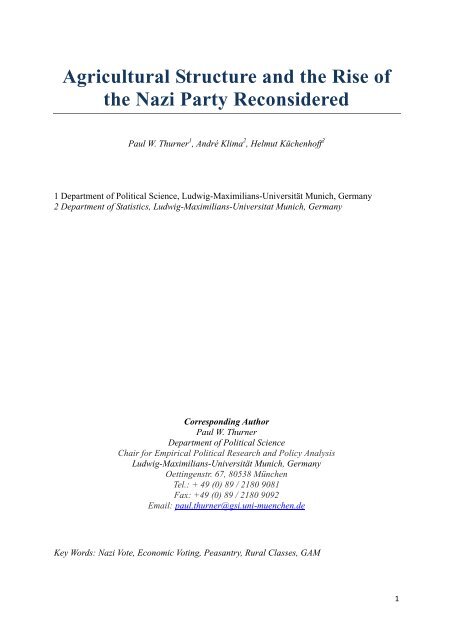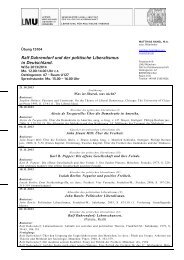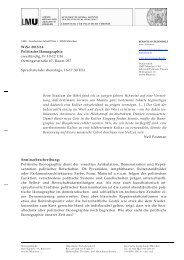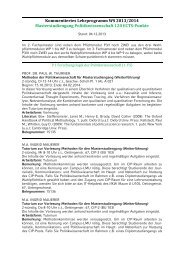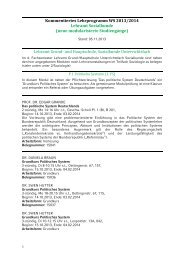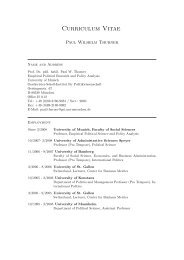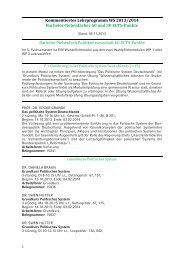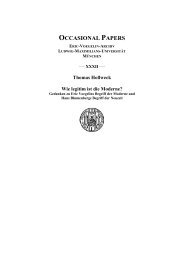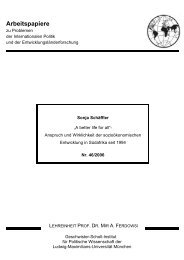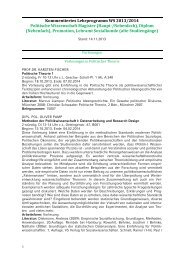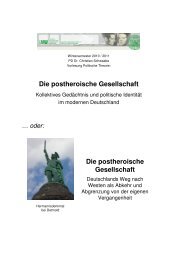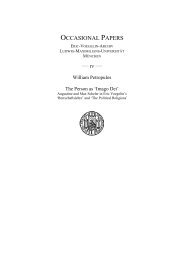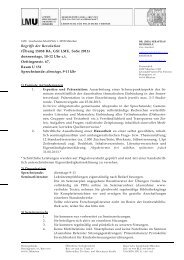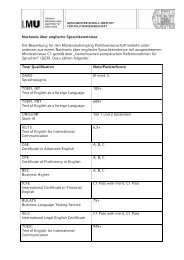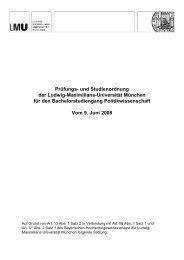Agricultural Structure and the Rise of the Nazi Party Reconsidered
Agricultural Structure and the Rise of the Nazi Party Reconsidered
Agricultural Structure and the Rise of the Nazi Party Reconsidered
Create successful ePaper yourself
Turn your PDF publications into a flip-book with our unique Google optimized e-Paper software.
<strong>Agricultural</strong> <strong>Structure</strong> <strong>and</strong> <strong>the</strong> <strong>Rise</strong> <strong>of</strong><br />
<strong>the</strong> <strong>Nazi</strong> <strong>Party</strong> <strong>Reconsidered</strong><br />
Paul W. Thurner 1 , André Klima 2 , Helmut Küchenh<strong>of</strong>f 2<br />
1 Department <strong>of</strong> Political Science, Ludwig-Maximilians-Universität Munich, Germany<br />
2 Department <strong>of</strong> Statistics, Ludwig-Maximilians-Universitat Munich, Germany<br />
Corresponding Author<br />
Paul W. Thurner<br />
Department <strong>of</strong> Political Science<br />
Chair for Empirical Political Research <strong>and</strong> Policy Analysis<br />
Ludwig-Maximilians-Universität Munich, Germany<br />
Oettingenstr. 67, 80538 München<br />
Tel.: + 49 (0) 89 / 2180 9081<br />
Fax: +49 (0) 89 / 2180 9092<br />
Email: paul.thurner@gsi.uni-muenchen.de<br />
Key Words: <strong>Nazi</strong> Vote, Economic Voting, Peasantry, Rural Classes, GAM<br />
1
Abstract<br />
A recent analysis <strong>of</strong> <strong>the</strong> electoral success <strong>of</strong> <strong>the</strong> German <strong>Nazi</strong> party challenges <strong>the</strong> view that it<br />
was a “Catch-All <strong>Party</strong> <strong>of</strong> Protest” that attracted voters equally from all societal strata. We<br />
follow this incentive-based, economic voting perspective that accentuates <strong>the</strong> asymmetric<br />
electoral attractiveness <strong>of</strong> <strong>the</strong> NSDAP. More specifically, we propose to refocus <strong>the</strong> debate on<br />
<strong>the</strong> agricultural origins <strong>of</strong> this party. For <strong>the</strong> first time, we use a country-wide data set<br />
including <strong>the</strong> original categories <strong>of</strong> so-called parcel peasants (0-2 hectare), small-sized (2-5<br />
hectare) <strong>and</strong> medium-sized farmers (5-20 hectare). This fine-grained classification was<br />
introduced <strong>and</strong> behaviorally confirmed by <strong>the</strong> Statistical Office <strong>of</strong> <strong>the</strong> Weimar Republic at<br />
that time. However, a multitude <strong>of</strong> studies subjected <strong>the</strong> original farm sizes to different<br />
recombinations, e.g. to 0-20 hectare, <strong>the</strong>reby disregarding <strong>the</strong> socio-economic rationale<br />
underlying <strong>the</strong> basic classes. Using generalized additive models (GAM), we are able to<br />
identify a clear distinct impact <strong>of</strong> <strong>the</strong> proportion <strong>of</strong> agrarian middle class (5-20 hectare) on<br />
<strong>the</strong> <strong>Nazi</strong> vote – which <strong>the</strong>oretically unjustified recombinations <strong>of</strong> farm sizes do not have.<br />
2
“ […] in a sense <strong>the</strong> rise <strong>of</strong> <strong>the</strong> <strong>Nazi</strong> party in Germany between 1928 <strong>and</strong> 1933 was <strong>the</strong> last<br />
genuine mass movement <strong>of</strong> peasants, at least in <strong>the</strong> Protestant parts <strong>of</strong> Germany” (Hobsbawm<br />
1973: 20).<br />
Explaining <strong>the</strong> <strong>Rise</strong> <strong>of</strong> <strong>the</strong> <strong>Nazi</strong> <strong>Party</strong>: New Developments <strong>and</strong> Open Questions<br />
Since <strong>the</strong> publication <strong>of</strong> <strong>the</strong> book “Hitler’s voters” by Falter in 1991 (Falter 1991), <strong>the</strong><br />
electoral sociology <strong>of</strong> <strong>the</strong> rise <strong>the</strong> <strong>Nazi</strong> party seems to have reached a robust conclusion:<br />
Contrary to substantive parts <strong>of</strong> earlier research 1 , Falter considered <strong>the</strong> <strong>Nazi</strong> party not as <strong>the</strong><br />
result <strong>of</strong> socially disintegrated masses, nor <strong>of</strong> radicalized middle classes, but ra<strong>the</strong>r as a<br />
“Catch-All <strong>Party</strong> <strong>of</strong> Protest” 2 pr<strong>of</strong>iting similarly from all societal strata. Note that Falter’s<br />
conclusions were for <strong>the</strong> first time grounded on <strong>the</strong> collection <strong>of</strong> a highly detailed countrywide<br />
data set. 3 However, in a recent article, Gary King <strong>and</strong> coauthors (2008) contest Falter’s<br />
main conclusion. Using an economic voting perspective 4 , <strong>the</strong>y argue that <strong>the</strong> economic crisis<br />
led vulnerable societal strata to react in a systematic <strong>and</strong> distinct way:<br />
1<br />
This extensive literature differentiates between so-called mass <strong>and</strong> group approaches on <strong>the</strong> one h<strong>and</strong>, <strong>and</strong><br />
conflict, class-based <strong>and</strong> cleavage approaches on <strong>the</strong> o<strong>the</strong>r h<strong>and</strong>. Falter (1991) as well as King et al. (2008)<br />
provide detailed overviews on <strong>the</strong> discussion <strong>of</strong> <strong>the</strong> respective earlier approaches <strong>of</strong>, e.g., Seymour Lipset<br />
(1960), Walter D. Burnham (1972), <strong>and</strong> Reinhard Bendix (1952). An innovative contribution to specific<br />
aspects <strong>of</strong> <strong>the</strong> electoral geography <strong>of</strong> <strong>the</strong> <strong>Nazi</strong>s is provided by O’Loughlin 2002.<br />
2<br />
See also Falter 1990, 2002 where he calls <strong>the</strong> NSDAP <strong>the</strong> first German Volkspartei. See also Childers 1976,<br />
1983 where <strong>the</strong> NSDAP was for <strong>the</strong> first time considered a “catch-all protest party”.<br />
3<br />
Contrary, e.g., to Childers (1976) who used data for about 200 cities, or a series <strong>of</strong> regional analyses by<br />
Heberle (1934/1945), Loomis/Beegle (1946), Frey/Weck (1983) etc. For a critique <strong>of</strong> earlier data bases, see<br />
Falter/Gruner (1981).<br />
4<br />
For an earlier incentive-based or interest-based approach to Fascist voting, see Brustein (1988/1991).<br />
Brustein/ Falter (1994) apply <strong>the</strong> rationalist approach to <strong>the</strong> joining behavior <strong>of</strong> NSDAP members.<br />
3
“The interesting question is which groups voted for <strong>the</strong> <strong>Nazi</strong>s differently than <strong>the</strong> average. In<br />
answering this question, we focus on incentives in voting for <strong>the</strong> <strong>Nazi</strong>s.” (King et al. 2008:<br />
957)<br />
Their “incentives-based retrospective voting” (ibd: 952) approach delineates a so-called<br />
“working poor” segment which <strong>the</strong>y consider especially susceptible to vote for <strong>the</strong> <strong>Nazi</strong> party.<br />
In <strong>the</strong>ir view, this working poor segment is behaviorally distinct from <strong>the</strong> segment <strong>of</strong> those<br />
directly <strong>and</strong> immediately hit by <strong>the</strong> economic crisis, like laborers <strong>and</strong> <strong>the</strong> unemployed. The<br />
“natural” political supply parties for <strong>the</strong> latter segments continued to be <strong>the</strong> Social Democratic<br />
<strong>Party</strong> <strong>and</strong> <strong>the</strong> Communist <strong>Party</strong>. However, those for which <strong>the</strong> economic crisis was tangible in<br />
a ra<strong>the</strong>r intermediate <strong>and</strong> imminent way esteemed <strong>the</strong> NSDAP as a promising new political<br />
option. 5<br />
King et al. (2008) subsume self-employed, shopkeepers, independent artisans,<br />
pr<strong>of</strong>essionals, domestic employees <strong>and</strong> family members, lawyers, <strong>and</strong> small farmers etc.<br />
under <strong>the</strong> category “working poor.” The authors also provide economic incentives for <strong>the</strong><br />
religious affiliation-induced voting patterns – hi<strong>the</strong>rto unanimously acknowledged as <strong>the</strong><br />
dominant explanatory variable. 6<br />
More generally, <strong>the</strong>y suggest applying sophisticated<br />
statistical analyses for <strong>the</strong> testing <strong>of</strong> still open research questions with regard to <strong>the</strong> <strong>Nazi</strong><br />
phenomenon. Using a new variant <strong>of</strong> ecological inference, 7 <strong>the</strong>y estimate <strong>the</strong> actual shares <strong>of</strong><br />
different groups voting for <strong>the</strong> NSDAP. In order to detect <strong>the</strong>se groups’ voting behavior, <strong>the</strong>y<br />
5<br />
“In contrast, we find that those who were hurt most by <strong>the</strong> depression <strong>and</strong> wound up supporting <strong>the</strong> <strong>Nazi</strong>s<br />
were those at little risk <strong>of</strong> being unemployed.” (King et al 2008: 951).<br />
6<br />
The authors argue that “<strong>Nazi</strong> agricultural policy did not appeal to peasant workers in Catholic precincts; <strong>and</strong><br />
domestic workers in Catholic regions benefited from government programs (while <strong>the</strong> self-employed did<br />
not). In addition, <strong>the</strong> self-employed would not be as heavily influenced by <strong>the</strong> Catholic Church because <strong>the</strong><br />
benefits from <strong>Nazi</strong> policy in favor <strong>of</strong> small business were just too tempting” (King et al. 2008: 965).<br />
7<br />
Where individual choices are inferred from aggregate data, see e.g. King et al. (1999).<br />
4
divide <strong>the</strong> German Reich into six homogenous regions along different shares <strong>of</strong><br />
unemployment <strong>and</strong> religious affiliation. Based on this design, <strong>the</strong> results fully corroborate <strong>the</strong><br />
“working poor” <strong>the</strong>sis <strong>and</strong>, thus contribute essentially to our underst<strong>and</strong>ing <strong>of</strong> <strong>the</strong> asymmetric<br />
nature <strong>of</strong> <strong>the</strong> swing towards <strong>the</strong> <strong>Nazi</strong>s.<br />
In <strong>the</strong> following, we propose to focus on one segment that has been surprisingly neglected by<br />
scientists, despite <strong>the</strong> consensus that <strong>the</strong> NSDAP became a “rural party” by <strong>the</strong> end <strong>of</strong> <strong>the</strong><br />
1920s, i.e. on <strong>the</strong> peasants:<br />
“An urban-to-rural realignment in <strong>the</strong> <strong>Nazi</strong> vote occurred between 1928 <strong>and</strong> 1933. Some<br />
districts realigned as early as 1928. About half had done so with <strong>the</strong> elections <strong>of</strong> 1930, <strong>and</strong> all<br />
but one did so with <strong>the</strong> election <strong>of</strong> 1933” (Waldman 1973: 140)<br />
Waldman also stresses <strong>the</strong> idea that <strong>the</strong>re was an interaction between confessional affiliation<br />
<strong>and</strong> rural segments “…that religion intervened between strain <strong>and</strong> <strong>the</strong> political reaction to it,<br />
that is that Protestants reacted differently to strain than did Catholics.” (1973: 94).<br />
Whereas King et al. conceive <strong>of</strong> small farmers as part <strong>of</strong> <strong>the</strong>ir “working poor” segment<br />
(2008: 961), <strong>the</strong>ir measurement is ra<strong>the</strong>r indirect because it relies exclusively upon <strong>the</strong> broad<br />
category “self-employed” – which includes non-agrarian self-employed as well as selfemployed<br />
owners <strong>of</strong> very small, medium-sized <strong>and</strong> somewhat larger farms. 8<br />
The size <strong>of</strong> farms constitutes <strong>the</strong> fundamental factor <strong>of</strong> rural stratification (see Loomis/Beegle<br />
1946). After <strong>the</strong> abolishment <strong>of</strong> feudal corporations in Europe, <strong>the</strong> size <strong>of</strong> farms determines<br />
<strong>the</strong> social <strong>and</strong> economic status <strong>of</strong> peasants. Thus, <strong>the</strong> statistical classification <strong>of</strong> farm sizes<br />
8<br />
“[…] i.e., independent artisans, shopkeepers, small farmers, <strong>and</strong> a smaller group <strong>of</strong> industrial employers that<br />
we cannot separate out [...]”, see King et al. (2008): 969.<br />
5
ecomes essential in determining socially <strong>and</strong> politically relevant rural strata. The Office <strong>of</strong><br />
Statistics <strong>of</strong> <strong>the</strong> Weimar Republic distinguished <strong>the</strong> following categories: 9<br />
Table 1: Categories <strong>of</strong> Farm Size<br />
Farms size (hectare: ha = 10 000 m 2 ) Category<br />
0-2 ha Parcel farms<br />
2-5 ha Small farms<br />
5-20 ha Medium sized farms<br />
20-100 ha Large farms<br />
100 ha <strong>and</strong> more Large estates<br />
In <strong>the</strong>ir early studies, Heberle (1934/1945) <strong>and</strong> Loomis/Beegle (1946) closely follow <strong>the</strong><br />
reasoning <strong>of</strong> <strong>the</strong> Official Statistics <strong>of</strong> <strong>the</strong> Reich, <strong>and</strong>, accordingly, expect small farms (2-5 ha)<br />
<strong>and</strong> medium-sized (5-20 ha) as <strong>the</strong> politically most relevant strata with <strong>the</strong> highest tendency to<br />
choose <strong>the</strong> <strong>Nazi</strong> party. Heberle (1934/1963, 1945) <strong>and</strong> Loomis/Beegle (1946) corroborate<br />
<strong>the</strong>ir hypo<strong>the</strong>ses empirically – but only for selected, sometimes highly aggregated regions.<br />
Later, Waldman (1973) operationalized farm sizes 2-100 ha 10 as family farms <strong>and</strong>, <strong>the</strong>refore,<br />
as politically relevant with regard to <strong>Nazi</strong> voting. Falter (1986, 1991), using a country-wide<br />
data set, combines <strong>the</strong> categories <strong>of</strong> parcel peasants (0-2 ha), small farms (2-5 ha) <strong>and</strong><br />
medium-sized (5-20 ha) farms into one single category which he labels “medium-sized farms”<br />
(0-20 ha). Additionally, he also constructs a measure <strong>of</strong> a so-called “average farm size” 11 as<br />
an indicator <strong>of</strong> medium-sized farms. Third, he used <strong>the</strong> indicator <strong>of</strong> <strong>the</strong> share <strong>of</strong> family<br />
workers as a complementary indicator for medium-sized farms. The respective correlations –<br />
as will be shown in more detail below – are small or non-existent, sometimes even negative.<br />
9<br />
10<br />
See Statistik des Deutschen Reichs (1929).<br />
Waldman (1973):181, FN.: 3, see also Table 43 on p. 198 where he actually correlates 2-20 ha <strong>and</strong> 20-100 ha<br />
with <strong>the</strong> <strong>Nazi</strong> vote, respectively.<br />
11<br />
I.e., <strong>the</strong> mean value <strong>of</strong> farm sizes in a district.<br />
6
In sum, Falter’s (1986, 1991) results on <strong>the</strong> (non-)impact <strong>of</strong> farm sizes, are in our view still<br />
inconclusive – <strong>the</strong>oretically as well as methodically.<br />
Thus, <strong>the</strong>re remains a surprising <strong>and</strong> obvious puzzle: Was <strong>the</strong> rural <strong>Nazi</strong> vote, at least since<br />
<strong>the</strong> 1930s, a phenomenon <strong>of</strong> radicalized agrarian middle classes – as argued by Geiger (1932),<br />
Heberle (1934/1963, 1945), Loomis/Beegle (1946), Lipset (1960), <strong>and</strong> Linz (1976)? Or<br />
should <strong>the</strong> rural vote also be conceived <strong>of</strong> as a ‘catch-all party <strong>of</strong> protest’ phenomenon – i.e.,<br />
<strong>the</strong> <strong>Nazi</strong>s attracted from all <strong>of</strong> <strong>the</strong> agrarian societal strata more or less equally? Based on <strong>the</strong><br />
“ruralization argument” (Waldman 1973), on <strong>the</strong> “incentive-based” reasoning <strong>of</strong> Linz (1976),<br />
Brustein (1988, 1991) <strong>and</strong> King et al. (2008), as well as using a completely new data set, we<br />
consider it necessary to reopen <strong>the</strong> discussion on <strong>the</strong> genuine agricultural social origins <strong>of</strong> <strong>the</strong><br />
spread <strong>of</strong> <strong>the</strong> <strong>Nazi</strong> party. This is <strong>the</strong> first country-wide study using <strong>the</strong> original classification<br />
<strong>of</strong> parcel peasants (0-2 ha), small-sized (2-5 ha) <strong>and</strong> medium-sized farmers (5-20 ha) from <strong>the</strong><br />
Weimar Republic– i.e.: as introduced by <strong>the</strong> Office <strong>of</strong> Statistics <strong>of</strong> <strong>the</strong> Weimar Republic, <strong>and</strong><br />
as used by <strong>the</strong> classic regional study by Heberle (1934/1963, 1945).<br />
In <strong>the</strong> following, we provide, first, a short overview on <strong>the</strong> literature on <strong>the</strong> agricultural crisis<br />
in <strong>the</strong> Weimar Republic. Then, we briefly review <strong>the</strong> quantitative literature on <strong>the</strong> relation<br />
between agricultural structure <strong>and</strong> <strong>the</strong> <strong>Nazi</strong> vote. Based on rural sociology <strong>and</strong> <strong>the</strong> macrosociological<br />
literature on peasant dissent <strong>and</strong> social revolution, we derive four hypo<strong>the</strong>ses on<br />
<strong>the</strong> rural basis <strong>of</strong> <strong>the</strong> <strong>Nazi</strong>s <strong>and</strong> its interaction with <strong>the</strong> confessional affiliation <strong>of</strong> districts.<br />
Hypo<strong>the</strong>ses are tested for <strong>the</strong> first time by using <strong>the</strong> fine-grained original classification <strong>of</strong> <strong>the</strong><br />
Official Statistics. Next, we introduce data <strong>and</strong> present a new statistical approach to <strong>the</strong> study<br />
<strong>of</strong> <strong>the</strong> <strong>Nazi</strong> party, so-called generalized additive models. Finally, we discuss our empirical<br />
results, which indicate a clear middle class basis <strong>of</strong> <strong>the</strong> rural <strong>Nazi</strong> vote since <strong>the</strong> 1932<br />
elections.<br />
7
<strong>Agricultural</strong> Crisis <strong>and</strong> Political Interest Representation <strong>of</strong> Peasants in <strong>the</strong> Weimar<br />
Republic<br />
The importance <strong>of</strong> <strong>the</strong> peasantry for <strong>the</strong> rise <strong>of</strong> <strong>the</strong> <strong>Nazi</strong>s was recognized very early (Heberle<br />
1934/1963, 1945, Friedrich 1937, Loomis/Beegle 1946). As a consequence, <strong>the</strong> literature on<br />
<strong>the</strong> specific rural impact is extensive. There are numerous publications on <strong>the</strong> agricultural<br />
policy <strong>and</strong> on agrarian interest groups in <strong>the</strong> Weimar Republic by, e.g. Beyer (1965), Gies<br />
(1967), Gessner (1977), Schumacher (1978), Flemming (1978) <strong>and</strong> Osmond (1993).<br />
Seen from <strong>the</strong> perspective <strong>of</strong> economic history 12 , <strong>the</strong> political role <strong>of</strong> <strong>the</strong> agricultural sector in<br />
<strong>the</strong> Weimar Republic has been surprisingly disproportionate – as compared to its contribution<br />
to economic production, namely approx. 16 % <strong>of</strong> domestic net product in <strong>the</strong> years 1925-1929<br />
(James 1986: 242). In 1925, approx. 30% <strong>of</strong> <strong>the</strong> workforce still constituted this sector – which<br />
sheds light on its low productivity as compared to <strong>the</strong> industrial sector. Within this sector, <strong>the</strong><br />
social stratification <strong>of</strong> <strong>the</strong> peasantry was highly differentiated. 13 In sum, more than 2 million<br />
peasants earned <strong>the</strong>ir living from <strong>the</strong>ir agricultural business. Only 1 % (N =23 000) <strong>of</strong> <strong>the</strong><br />
l<strong>and</strong>owners had very large l<strong>and</strong> estates (larger than 100 ha). Large peasants owning l<strong>and</strong><br />
consisting <strong>of</strong> 50-100 ha <strong>and</strong> so-called full farmers owning 20-50 ha l<strong>and</strong> estates represented<br />
13 % (ca. N=262 000). Middle peasants owning estates consisting <strong>of</strong> 5-25 ha represented<br />
18 % <strong>of</strong> <strong>the</strong> owners, small owners with 2-5 ha represented 17.5 %. More than 3 million socalled<br />
parcel peasants owned 0-2 ha. Whereas large estate owners, large peasants <strong>and</strong> full<br />
peasants were able to earn <strong>the</strong>ir living from <strong>the</strong>ir properties, l<strong>and</strong> owning was not <strong>the</strong><br />
12<br />
See Statistik des Deutschen Reichs (1929): table 20. Very useful historical overviews are provided, e.g., by<br />
James (1986), Wehler (2008): 331-342.<br />
13<br />
For <strong>the</strong> following, see <strong>the</strong> social history-oriented resume by Wehler (2008): 331ff, see also Geiger (1932):<br />
30-34.<br />
8
exclusive source <strong>of</strong> livelihood for parcel peasants. They had to rely on an additional<br />
occupation, e.g. serving as a l<strong>and</strong> laborer, which was perceived as degrading in <strong>the</strong> rural status<br />
hierarchy. Owners with mid-sized farms constituted a distinctive social sphere – <strong>the</strong>y were <strong>the</strong><br />
aspiration group for small peasants as well as <strong>the</strong>mselves driven by an intense aspiration to<br />
advance to <strong>the</strong> level <strong>of</strong> large peasant ownership.<br />
The slow adjustment <strong>of</strong> German farmers to more rational <strong>and</strong> modern production regimes – in<br />
order to keep pace with decreasing world market prices for agricultural products – was due to<br />
protective tariff interventions set in <strong>the</strong> 1890s <strong>of</strong> <strong>the</strong> German Empire (Kaiserreich). Restrictive<br />
tariff policies reflected <strong>the</strong> political power <strong>of</strong> very large l<strong>and</strong> owners in Eastern Germany<br />
specialized in grains. Additionally, German peasants were not able to pr<strong>of</strong>it from <strong>the</strong><br />
hyperinflation in <strong>the</strong> early twenties (see James 1986). World market prices for wheat began to<br />
decline in 1925. In 1926/27, a global crisis <strong>of</strong> agriculture compelled German farmers to take<br />
up loans in order to compensate for price reduction <strong>and</strong> price controls as well as for <strong>the</strong><br />
increase <strong>of</strong> taxes. From 1928 to 1932, German governments followed a highly protective tariff<br />
policy in order to secure wheat prices – agrarian protectionism became <strong>the</strong> “sacrosanct<br />
custom” (Wehler 2008: 314). However, <strong>the</strong>se interventions had no identical repercussions on<br />
<strong>the</strong> peasantry – due to its highly heterogeneous social <strong>and</strong> economic structure, namely with<br />
regard to farm sizes as well as with regard to product specialization (grains versus cattle).<br />
Protective tariff measures were beneficial mainly for large owners in Eastern Germany<br />
producing wheat.<br />
This heterogeneity <strong>of</strong> peasant’s economic interests impeded a country-wide interest<br />
representation by mainstream parties. E.g., <strong>the</strong> Bavarian part <strong>of</strong> <strong>the</strong> Catholic Center <strong>Party</strong><br />
9
(Zentrumspartei 14 ) was confronted with a niche party since 1893, 15 <strong>the</strong> Bavarian Peasants<br />
Alliance (Bayerischer Bauernbund) representing mostly small <strong>and</strong> medium-sized peasants.<br />
Also founded in 1893 was <strong>the</strong> Alliance <strong>of</strong> German Peasants (Bund der L<strong>and</strong>wirte) consisting<br />
mostly <strong>of</strong> Nor<strong>the</strong>rn <strong>and</strong> Eastern small, medium <strong>and</strong> large peasants, <strong>and</strong> only very marginally<br />
<strong>of</strong> large estates. Never<strong>the</strong>less, large proprietors <strong>of</strong> large estates took <strong>the</strong> leadership <strong>of</strong> this<br />
interest group, <strong>and</strong> fostered its adherence to <strong>the</strong> conservative party (Deutschnationale<br />
Volkspartei, DNVP). Inherent organizational tensions between small <strong>and</strong> medium-sized<br />
farmers on <strong>the</strong> one h<strong>and</strong>, <strong>and</strong> large farmers on <strong>the</strong> o<strong>the</strong>r h<strong>and</strong>, broke out during <strong>the</strong><br />
aggravation <strong>of</strong> <strong>the</strong> agrarian crisis by <strong>the</strong> end <strong>of</strong> <strong>the</strong> 1920s. Small <strong>and</strong> medium-sized peasant<br />
movements spread, <strong>and</strong> formed particular peasant parties, like <strong>the</strong> Christian-National Peasant<br />
Association (Christlich-nationale Bauernverein, CNBV) or <strong>the</strong> peasant movements in<br />
Schleswig-Holstein. The latter one became famous as a terroristic movement attracting<br />
attention due to violent events <strong>and</strong> even bomb attacks. In retrospect, most <strong>of</strong> <strong>the</strong>se antiestablishment<br />
peasant parties proved to be “flash parties” (Rose/Mackie, 1988) or<br />
“intermediate hosts” – <strong>the</strong>y mainly attracted <strong>the</strong> Protestant peasant clientele <strong>of</strong> <strong>the</strong><br />
conservative <strong>and</strong> liberal parties in <strong>the</strong> 1928 election <strong>and</strong> even, despite to already lower degree,<br />
in <strong>the</strong> 1930 election – but <strong>the</strong>ir electorate was <strong>the</strong>n nearly fully absorbed by <strong>the</strong> NSDAP in <strong>the</strong><br />
1932-1933 elections. Peasant parties in Catholic regions, like in Bavaria <strong>the</strong> Bayerische<br />
Bauernbund, experienced a similar decline but to a less extensive degree.<br />
14<br />
In 1918, <strong>the</strong> Bavarian People’s party (Bayerische Volkspartei) was founded, <strong>and</strong> became an autonomous,<br />
regional party <strong>of</strong> Catholicism.<br />
15<br />
For <strong>the</strong> concept <strong>of</strong> mainstream <strong>and</strong> niche parties, see Meguid (2008). Meguid provides an interesting<br />
perspective on how <strong>the</strong> performance <strong>of</strong> new niche parties is a function <strong>of</strong> <strong>the</strong> competitive strategies <strong>of</strong><br />
established mainstream parties. See also Hug (2001).<br />
10
Thus, heterogeneity <strong>of</strong> economic interests <strong>and</strong> <strong>the</strong> differential failure <strong>of</strong> political interest<br />
organization by interest groups as well as by parties led to <strong>the</strong> different levels <strong>of</strong> absorption <strong>of</strong><br />
peasant voters by <strong>the</strong> NSDAP in Catholic <strong>and</strong> Protestant regions, respectively. 16 Differences<br />
<strong>of</strong> <strong>Nazi</strong> voting in districts with different shares <strong>of</strong> religious denomination are mainly due to<br />
differences <strong>of</strong> <strong>the</strong> performance <strong>of</strong> established mainstream parties in dealing, first, with peasant<br />
discontent <strong>and</strong>, second, with respective challenging niche parties. In order to lure peasant<br />
voters in <strong>the</strong> 1928 election, Hitler modified a position <strong>of</strong> <strong>the</strong> NSDAP program by attenuating<br />
point 17 which postulated <strong>the</strong> expropriation <strong>of</strong> l<strong>and</strong>. Evidently, this position clearly frightened<br />
any self-employed peasant. In March 1930, <strong>the</strong> NSDAP promoted a first anti-crisis crash<br />
program for German agriculture. In July 1930, Hitler endowed Walter Darré with extensive<br />
organizational competencies for creating an aggressive campaign directed toward <strong>the</strong><br />
agricultural sector.<br />
In sum, <strong>the</strong> interplay between an exogenous shock (<strong>the</strong> global agrarian crisis), long-term<br />
structures <strong>of</strong> agriculture in Germany (rural stratification), <strong>and</strong> short-term decisions by agrarian<br />
elites, led to <strong>the</strong> disastrous failure <strong>of</strong> <strong>the</strong> system <strong>of</strong> agricultural interest mediation. Whereas<br />
very large <strong>and</strong> large farmers continued to adhere to <strong>the</strong> liberal, conservative <strong>and</strong> Catholic<br />
parties, respectively, economically-threatened small <strong>and</strong> medium sized farmers seemed to<br />
have been much more susceptible to <strong>Nazi</strong> propag<strong>and</strong>a, <strong>and</strong> <strong>the</strong>refore became electorally<br />
volatile. In <strong>the</strong> following, we will discuss how quantitative electoral studies dealt with this<br />
topic <strong>and</strong> what results <strong>the</strong>y have produced so far.<br />
16<br />
Despite highlighting <strong>the</strong> differential performance <strong>of</strong> interest representation by Protestant parties due to<br />
heterogeneity <strong>of</strong> interests, our argument is in line with Burnham’s (1972) political confessionalism argument<br />
<strong>and</strong> Shively’s (1972) conclusion on within-bloc voting along established cleavage lines.<br />
11
<strong>Agricultural</strong> <strong>Structure</strong> <strong>and</strong> <strong>the</strong> <strong>Rise</strong> <strong>of</strong> <strong>the</strong> NSDAP: Main Quantitative Results<br />
There are surprisingly few quantitative analyses <strong>of</strong> <strong>the</strong> electoral success <strong>of</strong> <strong>the</strong> <strong>Nazi</strong> party<br />
focusing on agrarian aspects – as compared to determinants like confessional affiliation <strong>and</strong><br />
unemployment. Originally, Falter considered <strong>the</strong> agricultural aspect <strong>of</strong> <strong>the</strong> <strong>Nazi</strong> movement as<br />
one <strong>of</strong> <strong>the</strong> most important open research questions (see Falter 1980: 187). One reason was that<br />
previous research studies, like <strong>the</strong> one by Childers (1976), especially investigated <strong>the</strong> urban<br />
origin <strong>of</strong> <strong>the</strong> <strong>Nazi</strong> voters. Secondly, <strong>the</strong> early studies by Heberle (1934/1963, 1946) <strong>and</strong><br />
Loomis/Beegle (1946) were considered too regionally focused <strong>and</strong> <strong>the</strong>refore not<br />
representative (see Falter 1980: 187). However, only one regional in-depth study <strong>of</strong> Franconia<br />
by Falter finally investigated <strong>the</strong> agricultural bases <strong>of</strong> <strong>the</strong> NSDAP in a more detailed way<br />
(Falter 1986). A final summary <strong>of</strong> <strong>the</strong> country-wide relationship between rural stratification<br />
<strong>and</strong> <strong>the</strong> <strong>Nazi</strong> vote is provided in Falter’s book (1991: 256-266)<br />
In <strong>the</strong> following, we shortly review <strong>the</strong> respective methodical approaches <strong>and</strong> <strong>the</strong> most<br />
important results <strong>of</strong> <strong>the</strong>se studies. Heberle’s study “Rural Population <strong>and</strong> National Socialism”<br />
was already finalized in 1934. The sociological investigation <strong>of</strong> interest representation in<br />
Schleswig-Holstein from 1918 to 1932 is now a classic study in electoral research. The<br />
starting point was <strong>the</strong> early <strong>and</strong> rapid breakthrough <strong>of</strong> <strong>the</strong> NSDAP in Schleswig-Holstein<br />
since 1930. Before that time, Bavaria <strong>and</strong> especially Franconia exhibited <strong>the</strong> highest NSDAP<br />
shares. For <strong>the</strong> contemporary observer, it seemed obvious that <strong>the</strong> success was due to a<br />
radicalized peasantry. Inspired by <strong>the</strong> approach <strong>of</strong> electoral geography <strong>and</strong> using <strong>the</strong> method<br />
<strong>of</strong> an internal comparison across different agricultural regions in Schleswig-Holstein, Heberle<br />
tries to identify <strong>the</strong> specific agro-economic incentives <strong>of</strong> <strong>the</strong> peasants in voting for <strong>the</strong><br />
NSDAP. Specific soil conditions, modes <strong>of</strong> production <strong>and</strong> social stratification are conceived<br />
as crucial determinants <strong>of</strong> voting behavior in this view (see Heberle 1963: 41). Based on <strong>the</strong>se<br />
considerations, he derives, inter alia, <strong>the</strong> hypo<strong>the</strong>sis that <strong>the</strong> l<strong>and</strong>slide from liberal parties<br />
12
towards <strong>the</strong> <strong>Nazi</strong>s was faster in crisis-prone regions with relatively less diversified production<br />
modes <strong>and</strong> less wealthy peasants (see Heberle 1963: 99). Heberle proposes a series <strong>of</strong> highlydifferentiated<br />
hypo<strong>the</strong>ses, which are tested on <strong>the</strong> basis <strong>of</strong> 30 rural districts <strong>and</strong> using rank<br />
correlation. The main result is that regions characterized by small- <strong>and</strong> medium sized farms<br />
exhibit higher electoral shares for <strong>the</strong> NSDAP:<br />
“More specifically, it may be said that <strong>the</strong> classes particularly susceptible for <strong>Nazi</strong>sm were<br />
nei<strong>the</strong>r <strong>the</strong> rural nobility <strong>and</strong> big farmers nor <strong>the</strong> rural proletariat, but ra<strong>the</strong>r <strong>the</strong> small farm<br />
proprietors, very much <strong>the</strong> rural equivalent <strong>of</strong> <strong>the</strong> lower middle class or petty bourgeoisie<br />
(Kleinbuergertum) which formed <strong>the</strong> backbone <strong>of</strong> <strong>the</strong> NSDAP in <strong>the</strong> cities.” (Heberle 1945:<br />
112)<br />
And:<br />
“It appears that <strong>the</strong> <strong>Nazi</strong>s in 1932 had really succeeded <strong>the</strong> former liberal parties […] as <strong>the</strong><br />
preferred party among <strong>the</strong> small farmers (2-20 ha).” (ibd: 114)<br />
Most important for our objective is <strong>the</strong> fact that Heberle already discusses in detail which<br />
farm sizes (Heberle 1963: 114) should be considered politically relevant with regard to <strong>the</strong><br />
<strong>Nazi</strong> l<strong>and</strong>slide. He proposes combining <strong>the</strong> <strong>of</strong>ficial categories <strong>of</strong> “small <strong>and</strong> medium-sized”<br />
farms 2-20 ha, “large peasant farms” from 20-100 ha <strong>and</strong> “large agricultural enterprises” with<br />
estates <strong>of</strong> more than 100 ha, as well as very small farms <strong>of</strong> 2 ha. Note that <strong>the</strong>se categories<br />
closely follow <strong>the</strong> predefined categories <strong>of</strong> <strong>the</strong> Official Statistics, which he considered a<br />
useful, sociologically oriented categorization capturing <strong>the</strong> agrarian middle classes 17 .<br />
Loomis/Beegle (1946) extend <strong>the</strong>ir analyses to <strong>the</strong> regions Hanover <strong>and</strong> Bavaria in order to<br />
vary <strong>the</strong> confessional context. Like Heberle, <strong>the</strong>y are interested in <strong>the</strong> analysis <strong>of</strong> <strong>the</strong><br />
17<br />
See also <strong>the</strong> discussion <strong>of</strong> <strong>the</strong>se categories by <strong>the</strong> sociologist Geiger (1932): 30-34.<br />
13
“economic <strong>and</strong> social structure <strong>and</strong> <strong>the</strong> situation <strong>of</strong> <strong>the</strong> rural population” (Loomis/Beegle<br />
1946: 729). They come to identical conclusions as Heberle (1934/1963): “Elements <strong>of</strong> <strong>Nazi</strong>sm<br />
became entrenched among those rural middle-class controlled areas whose residents were<br />
suffering most acutely from economic insecurity <strong>and</strong> anxiety accompanying loss <strong>of</strong> social<br />
solidarity” (Loomis/Beegle 1946: 725). Like Heberle, <strong>the</strong>y interpret <strong>the</strong>ir result as an<br />
indication that <strong>the</strong> rural middle class affected by economic insecurity was <strong>the</strong> segment most<br />
likely to vote for <strong>the</strong> <strong>Nazi</strong>s. A correlation analysis <strong>of</strong> <strong>the</strong> July 1932 election demonstrates that<br />
areas characterized by family-sized farms supported <strong>the</strong> NSDAP to higher degrees. NSDAP<br />
shares correlate highly in all three regions with percentages <strong>of</strong> farm sizes <strong>of</strong> <strong>the</strong> category 2-20<br />
ha, although to a lesser degree in Bavaria. In <strong>the</strong> case <strong>of</strong> Schleswig und Hanover, high<br />
correlations are also visible with large farm shares <strong>of</strong> size 20-100 ha.<br />
In his article “The rise <strong>of</strong> <strong>the</strong> NSDAP in Franconia in <strong>the</strong> elections 1924-1933”, Falter (1986)<br />
extensively investigates <strong>the</strong> relationship between agrarian structure <strong>and</strong> <strong>the</strong> <strong>Nazi</strong> vote in<br />
Franconia – a region with extremely high vote shares for <strong>the</strong> NSDAP already in 1920s.<br />
Because some authors considered Franconia a typical case, whereas o<strong>the</strong>rs declared it a<br />
deviating case, Falter aims to make a systematic comparison <strong>of</strong> <strong>the</strong> main explanatory<br />
variables in <strong>the</strong> Reich as a whole <strong>and</strong> in Franconia. For Franconia, as for <strong>the</strong> Reich, Falter<br />
argues that <strong>the</strong> relation between <strong>the</strong> size <strong>of</strong> <strong>the</strong> agricultural sector <strong>and</strong> <strong>the</strong> <strong>Nazi</strong> shares<br />
correlates 18 in Protestant regions since <strong>the</strong> 1932 elections – contrary to <strong>the</strong> results <strong>of</strong> Heberle<br />
(<strong>and</strong> later Waldman) according to which <strong>the</strong> rural breakthrough occurred already in 1930.<br />
Even more surprising is <strong>the</strong> fact that no relationship between mid-sized farms <strong>and</strong> <strong>the</strong> <strong>Nazi</strong><br />
vote shows up. This may be due to <strong>the</strong> operationalization <strong>of</strong> mid-sized farms: Contrary to<br />
18<br />
Using Pearson correlation coefficients <strong>and</strong> shares <strong>of</strong> employed persons in <strong>the</strong> agricultural sector: for<br />
Franconia: all correlations are less than 0.2, for <strong>the</strong> Reich: correlations in 1932 are 0.21 <strong>and</strong> 0.22 respectively,<br />
<strong>and</strong> 0.43 in 1933.<br />
14
Heberle, Loomis <strong>and</strong> Beegle, Falter combines <strong>the</strong> following farm sizes: 0-20 ha, 20-50 ha, 50-<br />
100 ha. Relying on a 0-20 ha combination <strong>of</strong> categories (see table 7 on p. 333), he detects<br />
ra<strong>the</strong>r small correlations in Franconia from 1924 to 1930 (.39, .39, .29, .30), turning into<br />
negative correlations in 1932 <strong>and</strong> 1933 – which runs completely counter to expectations. For<br />
<strong>the</strong> Reich, all respective correlations are below .20 – in <strong>the</strong> article as well as in <strong>the</strong> book (see<br />
1991: 259). 19 Partial correlation coefficients for <strong>the</strong> 0-20 ha category (controlling for shares <strong>of</strong><br />
Protestants) turn out to be even highly negative for <strong>the</strong> 1932 <strong>and</strong> 1933 election in <strong>the</strong> article<br />
(1986: 333). Never<strong>the</strong>less, Falter concludes in <strong>the</strong> article that <strong>the</strong> hypo<strong>the</strong>sis <strong>of</strong> <strong>the</strong> middle<br />
class character <strong>of</strong> <strong>the</strong> NSDAP on <strong>the</strong> countryside can be corroborated – at least since <strong>the</strong> July<br />
1932 election (Falter 1986: 335). This conclusion is mainly based on <strong>the</strong> result for <strong>the</strong> share <strong>of</strong><br />
family workers as an indicator <strong>of</strong> family-based farms (see tables 7a <strong>and</strong> 7b, p. 333-334). Note,<br />
that in his book, Falter (1991) withdraws his earlier conclusions <strong>of</strong> <strong>the</strong> 1986 article by<br />
accentuating <strong>the</strong> weak correlation between family workers <strong>and</strong> NSDAP shares. 20 Only in<br />
Protestant districts does <strong>the</strong> share <strong>of</strong> family workers seem to correlate with <strong>Nazi</strong> success (see<br />
Falter 1991: 261). In sum, Falter concludes that <strong>the</strong>re was no impact <strong>of</strong> farm sizes in <strong>the</strong><br />
country-wide study (1991: 265). Note also that this far-reaching conclusion is again explicitly<br />
based on <strong>the</strong> variable “average farm size” (1991: 265). Overall, <strong>the</strong> country-wide testing <strong>of</strong><br />
<strong>the</strong> different categories <strong>of</strong> farm sizes (0-20 ha, 20-50 ha. 50-100 ha, <strong>and</strong> >100 ha) does not<br />
indicate substantial correlations. Remember, however, that Geiger (1932) as well as Heberle<br />
(1934,1945, 1963) provide extensive discussions on why <strong>the</strong> political mentality <strong>of</strong> members<br />
<strong>of</strong> <strong>the</strong> category 0-2ha – so-called parcel peasants – is completely different from <strong>the</strong> one <strong>of</strong><br />
small <strong>and</strong> middle-sized holders:<br />
19<br />
Additionally, Falter correlates a variable “average farm size in a district” with <strong>the</strong> NSDAP vote. Due to<br />
problems <strong>of</strong> interpreting this variable, we do not report results.<br />
20<br />
See Falter (1991): 258, see also table 7.12 on p. 259 with correlations lower or equal .15.<br />
15
“Farm sizes between 0.5 <strong>and</strong> 2 ha, are, at least on <strong>the</strong> country-side, held by day laborers <strong>and</strong><br />
laborers for estates. Their income is mainly based on wages, whereas <strong>the</strong> usage <strong>of</strong> small<br />
pieces <strong>of</strong> l<strong>and</strong> is part <strong>of</strong> this. Farms <strong>of</strong> this size occur mainly in districts with large estates.<br />
Thus, farm sizes <strong>of</strong> 0.5 to 2 ha <strong>and</strong> more than 100 ha are complementary.” (Heberle 1963:<br />
115, translation by <strong>the</strong> authors)<br />
Falter does not provide an explicit justification for <strong>the</strong> recombination <strong>of</strong> farm sizes 0-20 ha.<br />
As a consequence, <strong>the</strong> relevance <strong>of</strong> <strong>the</strong> agrarian middle class for <strong>the</strong> success <strong>of</strong> <strong>the</strong> <strong>Nazi</strong>s is<br />
still an open question. In order to place <strong>the</strong> discussion into a broader comparative context, we<br />
refer to respective macro-sociological literature on agricultural structure <strong>and</strong> peasant<br />
movements in <strong>the</strong> following.<br />
<strong>Agricultural</strong> <strong>Structure</strong> <strong>and</strong> Peasant Political Action: Macro-Sociological Insights<br />
Which social <strong>and</strong> political conditions made German peasants susceptible to voting for <strong>the</strong><br />
<strong>Nazi</strong>s, or more generally for Fascist movements? In many macro-sociological approaches, <strong>the</strong><br />
peasantry is attributed a crucial role in <strong>the</strong> process <strong>of</strong> modernization, <strong>of</strong> democratization, <strong>of</strong><br />
political crises, <strong>and</strong> <strong>of</strong> revolutions (see Moore 1966, Huntington 1968, Taylor 1988, Skocpol<br />
1979). Authors like Hobsbawm (1973), Moore (1966), <strong>and</strong> Linz (1976) consider <strong>the</strong> role <strong>of</strong><br />
<strong>the</strong> German peasantry as crucial for <strong>the</strong> underst<strong>and</strong>ing <strong>of</strong> <strong>the</strong> take-over <strong>of</strong> <strong>the</strong> <strong>Nazi</strong>s <strong>and</strong> <strong>the</strong><br />
abolishment <strong>of</strong> democracy.<br />
According to Barrington Moore (1966), democratic systems develop only when traditional<br />
peasant production regimes <strong>of</strong> self-sufficiency become modernized, <strong>and</strong> <strong>the</strong> bourgeoisie does<br />
not build alliances with <strong>the</strong> proprietors <strong>of</strong> large estates. These coalitions are directed against<br />
<strong>the</strong> interests <strong>of</strong> small <strong>and</strong> middle peasants, <strong>and</strong> <strong>the</strong>y undermine <strong>the</strong> emergence <strong>of</strong> selfsustaining,<br />
not state-centered agricultural markets. The configuration for <strong>the</strong> road to fascism<br />
in Germany, Italy <strong>and</strong> Japan entails a coalition <strong>of</strong> <strong>the</strong> weak bourgeoisie with <strong>the</strong> l<strong>and</strong>ed upper<br />
16
class. 21 It is crucially <strong>the</strong> l<strong>and</strong>ed upper class that impedes <strong>the</strong> development <strong>of</strong> working classes<br />
as well as middle classes <strong>and</strong> <strong>the</strong>ir political organization. Authors like Stinchcombe (1961)<br />
<strong>and</strong> Paige (1975) accentuate <strong>the</strong> grievances <strong>and</strong> dependency <strong>of</strong> smallholder tenants <strong>and</strong> assess<br />
this stratum as <strong>the</strong> most susceptible for political rebellions. Contrary, Wolf (1969), Jenkins<br />
(1982) <strong>and</strong> Taylor (1988) hypo<strong>the</strong>size that <strong>the</strong> more rapid <strong>and</strong> <strong>the</strong> more encompassing <strong>the</strong><br />
process <strong>of</strong> <strong>the</strong> commercialization <strong>of</strong> agrarian products, <strong>the</strong> higher <strong>the</strong> probability that peasants<br />
revolt against <strong>the</strong>se processes. They argue that it is especially market-involved peasants with<br />
mid-sized farms, much less than indigent small tenants. According to Wolf (1969), it’s <strong>the</strong><br />
“middle peasantry” which is <strong>the</strong> “tactically mobile peasantry.” The author explains this fact by<br />
<strong>the</strong> discrepancy between a continuing traditional way <strong>of</strong> life <strong>and</strong>, at <strong>the</strong> same time, <strong>the</strong><br />
increasing involvement in <strong>and</strong> dependence on <strong>the</strong> market. This discrepancy is most painful for<br />
<strong>the</strong> middle peasantry.<br />
There are several insightful overviews <strong>of</strong> <strong>the</strong> extensive literature on rural stratification <strong>and</strong><br />
peasant political behavior (see Linz 1976, Skocpol 1979, Jenkins 1982, Lichbach 1994). They<br />
focus on <strong>the</strong> economic <strong>and</strong> social conditions <strong>of</strong> conventional <strong>and</strong> unconventional peasant<br />
political behavior, i.e. on <strong>the</strong> behaviorally relevant incentives <strong>of</strong> different rural strata. A<br />
continuous debate relates to <strong>the</strong> question <strong>of</strong> whe<strong>the</strong>r deprivation <strong>and</strong> class relations lead to<br />
quasi-spontaneous self-organization, or whe<strong>the</strong>r mobilization by organizational entrepreneurs<br />
(see Migdal 1974, Popkin 1979, Jenkins 1982, Lichbach 1994) causally precedes peasants’<br />
movements. Meanwhile, it seems to be acknowledged that <strong>the</strong> organization <strong>of</strong> peasant<br />
behavior is a necessary intermediate factor in order to overcome collective action problems<br />
(see Lichbach 1994).<br />
21<br />
See L<strong>and</strong>mann (2008): 115, 117 et passim, for an overview.<br />
17
For his comparative endeavor in assessing <strong>the</strong> relevance <strong>of</strong> rural social stratification to voting<br />
behavior, Linz (1976: 368-369) builds on <strong>the</strong> fundamental, complex typology <strong>of</strong> Sorokin et al.<br />
(1930: 360-370). Sorokin proposed <strong>the</strong> following criteria: a) property versus tenancy versus<br />
hired laborers, b) <strong>the</strong> size <strong>of</strong> farms, c) <strong>the</strong> (non-)market orientation <strong>of</strong> <strong>the</strong> farms (selfsufficient<br />
consumption versus pr<strong>of</strong>it-making), d) family work or inclusion <strong>of</strong> hired labor, <strong>and</strong><br />
d) <strong>the</strong> value <strong>of</strong> <strong>the</strong> soil <strong>and</strong> investments. 22 According to Linz, <strong>the</strong> rural stratum most<br />
susceptible to fascism are so-called “proprietors <strong>of</strong> farmer-capitalist agricultural enterprises”<br />
(Linz 1976: 375). They are highly market-oriented <strong>and</strong> <strong>the</strong>refore politically sensitive to<br />
economic crises <strong>and</strong> government policies. As long as <strong>the</strong>y rely on non-family hired workforce,<br />
<strong>the</strong>y are also hostile to socialist <strong>and</strong> communist parties. Contrary to consumptive or<br />
subsistence peasants, <strong>the</strong>y have no loyalties to traditional parties: “The political alternatives<br />
likely to appeal to <strong>the</strong>se strata are: various centrist <strong>and</strong> undefined forces; all kinds <strong>of</strong><br />
liberalism at <strong>the</strong> end <strong>of</strong> <strong>the</strong> century; conservative-nationalistic, anticlerical-conservative,<br />
peasant ideologies <strong>of</strong> various kinds; nontraditional ‘democratic’ conservative<br />
authoritarianism; Bonapartism, Boulangism, <strong>and</strong> <strong>the</strong> like; <strong>and</strong> finally, in <strong>the</strong> thirties, fascism.”<br />
(Linz 1976: 376). 23 This aligns with Heberle’s assessment that <strong>the</strong> transition from liberal<br />
parties to <strong>the</strong> NSDAP was due to “increasing economic insecurity ra<strong>the</strong>r than actual suffering<br />
22<br />
Sorokin et al. combine <strong>the</strong>se criteria in order to propose a differentiated hierarchy <strong>of</strong> agrarian social<br />
stratification. Linz (1976) builds extensively on this typology <strong>and</strong> tests its usefulness for <strong>the</strong> underst<strong>and</strong>ing <strong>of</strong><br />
rural voting behavior in Europe. He distinguishes mainly “proprietors <strong>of</strong> large, latifundium-type agricultural<br />
enterprises” (p. 370), “proprietors <strong>of</strong> smaller capitalist agricultural enterprises” (p. 373), “managers or tenants<br />
<strong>of</strong> large capitalist enterprises” (p. 375), “proprietors <strong>of</strong> farmer-capitalist agricultural enterprises” (p. 375),<br />
“proprietors <strong>of</strong> peasant consumptive enterprises” (<strong>the</strong> subsistence farmer) (p. 383), small “tenants” (p. 402),<br />
<strong>and</strong> “farm laborers” (p. 412).<br />
23<br />
For a similar argument see Lipsets (1950) work on <strong>the</strong> development <strong>of</strong> a mass socialist movement in<br />
Saskatchewan.<br />
18
from agricultural depression.” (Heberle 1946: 104). As <strong>the</strong> traditional “supply parties”, i.e.<br />
conservative as well as bourgeois parties, were more <strong>and</strong> more dominated by industrial<br />
bourgeoisie <strong>and</strong> large l<strong>and</strong> owners, <strong>the</strong> insecure proto-capitalist peasants became politically<br />
volatile. 24<br />
The crucial phase in <strong>the</strong> transition to modernity begins when peasants are confronted with <strong>the</strong><br />
challenges <strong>of</strong> <strong>the</strong> commercialization <strong>of</strong> <strong>the</strong>ir products. In his comparative analysis <strong>of</strong> agrarian<br />
movements in Europe 1850-1940, Urwin (1980) demonstrates in detail <strong>the</strong> “interconnection<br />
between agrarian structure, socio-economic change <strong>and</strong> political activity” (Urwin 1980: 12).<br />
The causes for <strong>the</strong> numerous agrarian movements in this period are rooted in <strong>the</strong> rapid<br />
acceleration <strong>of</strong> industrialization suddenly questioning <strong>the</strong> status <strong>of</strong> agriculture as <strong>the</strong> primary<br />
mode <strong>of</strong> production. The peasantry was confronted with <strong>the</strong> implications <strong>of</strong> transnational<br />
trade flows as well as with <strong>the</strong> consequences <strong>of</strong> urbanization <strong>and</strong> democratization. Thus, it<br />
was forced to defend its influence on <strong>the</strong> political market. However, <strong>the</strong> foundation <strong>and</strong><br />
especially: <strong>the</strong> institutionalization <strong>of</strong> peasant parties has been ra<strong>the</strong>r <strong>the</strong> exception. 25 This<br />
implies that peasants have been forced to seek alternative voice <strong>and</strong> exit options.<br />
The pressure put on <strong>the</strong> peasantry by <strong>the</strong> expansiveness <strong>of</strong> <strong>the</strong> international agrarian market<br />
manifests itself in tariff policies leading to a sharp antagonism between cities <strong>and</strong> <strong>the</strong><br />
countryside. The overall decline <strong>of</strong> <strong>the</strong> agricultural sector accelerated after 1918 <strong>and</strong> induced a<br />
new era <strong>of</strong> peasant mobilization: “In most <strong>of</strong> Western European countries, <strong>the</strong> most significant<br />
rural break-through since <strong>the</strong> beginning <strong>of</strong> mass politics occurred in <strong>the</strong> late 1920s <strong>and</strong> early<br />
1930s: Norway <strong>and</strong> Sweden are by no means exceptional in this respect. The most dramatic<br />
instances <strong>of</strong> a sharp upsurge occurred in Germany” (Urwin 1980: 129, see also Osmond<br />
24<br />
25<br />
In his analysis <strong>of</strong> Rexism in Belgium, Brustein (1988) corroborates <strong>the</strong>se insights.<br />
See Mackie/Rose (1988), <strong>and</strong> <strong>the</strong> ex-post-predictions by Lipset/Rokkan (1967).<br />
19
1982). The causes have been <strong>the</strong> modernization <strong>of</strong> agriculture <strong>and</strong> <strong>of</strong> <strong>the</strong> food economy, <strong>the</strong><br />
creation <strong>and</strong> restructuring <strong>of</strong> national <strong>and</strong> international agrarian markets as well as <strong>the</strong><br />
contradiction between exp<strong>and</strong>ing industrial sector <strong>and</strong> agricultural sector. As countries in<br />
Latin America became producers for <strong>the</strong> world market, a pr<strong>of</strong>ound change <strong>of</strong> <strong>the</strong> existing<br />
agro-economic <strong>and</strong> social structure occurred which culminated in a world agrarian crisis. 26<br />
European fascism was one <strong>of</strong> its beneficiaries (see Urwin 1980: 81, see also Osmond 1982).<br />
Urwin refers to <strong>the</strong> success <strong>of</strong> <strong>the</strong> <strong>Nazi</strong>s in Bavaria, Hessie, to Rexism in Belgium (see also<br />
Brustein 1988) <strong>and</strong> <strong>the</strong> Quisling in Norway as well as to diverse agro-fascist movements in<br />
Eastern Europe (Urwin 1980: 182). The anti-system potential <strong>of</strong> peasants was always<br />
unleashed “...whenever <strong>the</strong> agrarian parties failed to react to <strong>the</strong> current economic programs<br />
<strong>of</strong> <strong>the</strong> peasantry” (Urwin 1980: 182).<br />
Hypo<strong>the</strong>ses<br />
This short overview on <strong>the</strong> role <strong>of</strong> <strong>the</strong> peasantry, <strong>and</strong> especially <strong>of</strong> specific strata within <strong>the</strong><br />
highly diversified agricultural status hierarchy refers to macrosociological debates. Some <strong>of</strong><br />
<strong>the</strong>se studies derive <strong>the</strong>ir conclusions from developing countries (e.g. Migdal 1974, Paige<br />
1975, Wolf 1969, Popkin 1979 ). However, <strong>the</strong>y detect general social incentives that can be<br />
now tested for our case. First, <strong>the</strong>re is a still unresolved debate as to whe<strong>the</strong>r parcel peasants<br />
(small tenants) <strong>and</strong> farm laborers (e.g, Stinchcombe 1961 Paige 1975), or instead mediumsized<br />
farms (e.g. Wolf 1969, Jenkins 1982, Taylor 1988) are more susceptible to discontent<br />
<strong>and</strong> anti-system movements. More specifically, with regard to <strong>the</strong> electoral success <strong>of</strong> <strong>the</strong><br />
<strong>Nazi</strong>s, <strong>the</strong> question remains whe<strong>the</strong>r <strong>the</strong>y were heavily supported by mid-sized farms (Heberle<br />
1934/1963, 1946, Loomis/Beegle 1946, Linz 1976), or whe<strong>the</strong>r parcel peasants <strong>and</strong> farm<br />
26<br />
For <strong>the</strong> relevance <strong>of</strong> external developments to internal unrest, see Skocpol (1979).<br />
20
laborers supported <strong>the</strong> <strong>Nazi</strong>s to <strong>the</strong> same degree as mid-sized farms (as implied by Falter<br />
1986, 1991), <strong>and</strong> whe<strong>the</strong>r <strong>the</strong>re was no separate impact <strong>of</strong> different rural strata at all (Falter<br />
1991). Therefore, <strong>the</strong> following hypo<strong>the</strong>ses can be formulated:<br />
Hypo<strong>the</strong>sis 1 (Heberle 1934/1963, 1946, Loomis/Beegle 1946, Linz 1976 etc.)<br />
The higher <strong>the</strong> share <strong>of</strong> mid-sized peasants (5-20 ha), <strong>the</strong> higher <strong>the</strong> vote shares <strong>of</strong> <strong>the</strong><br />
NSDAP.<br />
Hypo<strong>the</strong>sis 2: (Heberle 1934/1963, 1946, Loomis/Beegle 1946, Linz 1976 etc.)<br />
The higher <strong>the</strong> share <strong>of</strong> parcel peasants (0-2 ha), <strong>the</strong> lower <strong>the</strong> vote shares <strong>of</strong> <strong>the</strong> NSDAP.<br />
Hypo<strong>the</strong>sis 3a (Falter 1986, 1991):<br />
The relationship between <strong>the</strong> share <strong>of</strong> parcel peasants (0-2 ha), small-sized peasants (2-5 ha),<br />
mid-sized peasants (5-20 ha) <strong>and</strong> <strong>the</strong> vote shares <strong>of</strong> <strong>the</strong> NSDAP is identical.<br />
Hypo<strong>the</strong>sis 3b (Falter 1986, 1991):<br />
There is no relation between <strong>the</strong> composite stratum (0-20 ha) with <strong>the</strong> electoral results <strong>of</strong> <strong>the</strong><br />
NSDAP.<br />
In line with <strong>the</strong> conclusions <strong>of</strong> Heberle (1934), Geiger (1932), Loomis/Beegle (1946) <strong>and</strong><br />
Linz (1976), we expect mid-size farmers (5-20 ha) to have been especially vulnerable to <strong>the</strong><br />
campaign <strong>of</strong> <strong>the</strong> NSDAP. Due to its specific structural economic position, this stratum was<br />
generally more politically instable as it had no long-term loyalties towards mainstream parties<br />
in <strong>the</strong> established German cleavage structure. Contrary, <strong>the</strong> organizational entrepreneurs for<br />
farm laborers <strong>and</strong> parcel peasants were <strong>the</strong> established Social-Democratic <strong>Party</strong> (SPD), <strong>and</strong><br />
<strong>the</strong> Communist <strong>Party</strong> (KPD). The political representation <strong>of</strong> <strong>the</strong> proprietors <strong>of</strong> farmercapitalist<br />
agricultural enterprises until <strong>the</strong> agricultural crisis was mainly organized by <strong>the</strong><br />
Protestant Conservative <strong>Party</strong> (DNVP), <strong>and</strong> <strong>the</strong> Catholic Parties (Center <strong>Party</strong>, Bavarian<br />
People’s <strong>Party</strong>, Bavarian Peasants’ Alliance). Inspired by mass <strong>the</strong>ories, Waldman (1973)<br />
21
argued that Protestant voters in general <strong>and</strong> Protestant peasants were socially disintegrated,<br />
<strong>and</strong> <strong>the</strong>refore concluded: “…that religion intervened between strain <strong>and</strong> <strong>the</strong> political reaction<br />
to it, that is that Protestants reacted differently to strain than did Catholics.” (Waldman 1973:<br />
94). As a consequence, he expects a “continuum <strong>of</strong> <strong>Nazi</strong> voters” (1973: 123), <strong>and</strong> specified<br />
this hypo<strong>the</strong>sis as an additional interaction term between <strong>the</strong> share <strong>of</strong> Protestants <strong>and</strong> <strong>the</strong> share<br />
<strong>of</strong> workforce in <strong>the</strong> agricultural sector. We would like to adjust this hypo<strong>the</strong>sis to our<br />
incentive-based approach: In <strong>the</strong> case <strong>of</strong> <strong>the</strong> Protestant party, Conservative <strong>Party</strong> (DNVP),<br />
<strong>the</strong>re was an inherent conflict <strong>of</strong> interest because this party was predominantly led by elites <strong>of</strong><br />
<strong>the</strong> large Eastern Protestant estates. The secession <strong>of</strong> <strong>the</strong> small Protestant agrarian Christlich-<br />
Nationale Bauern- und L<strong>and</strong>volkpartei (CNBV) in 1928 actually did not overcome <strong>the</strong><br />
domination by <strong>the</strong>se elites. These organizational efforts to unify <strong>the</strong> Protestant small- <strong>and</strong><br />
medium-sized peasants failed, <strong>and</strong> <strong>the</strong> party proved to be a flash party, which was completely<br />
absorbed in <strong>the</strong> 1932 elections by <strong>the</strong> NSDAP. In <strong>the</strong> Catholic peasant camp, <strong>the</strong>re were also<br />
efforts in 1928 to exp<strong>and</strong> <strong>the</strong> Bavarian Peasants Association to <strong>the</strong> Reich by founding <strong>the</strong><br />
German Peasants <strong>Party</strong>. However, this attempt failed from <strong>the</strong> beginning. As <strong>the</strong> original<br />
Catholic “supply” parties were mainly directed by elites traditionally oriented towards small<br />
<strong>and</strong> mid-sized farm tenants, we expect <strong>the</strong> flows <strong>of</strong> mid-sized peasants towards <strong>the</strong> <strong>Nazi</strong> party<br />
to be smaller in <strong>the</strong> Catholic rural districts <strong>of</strong> <strong>the</strong> Reich. Thus, economic heterogeneity along<br />
confessional lines played indeed a central role (see King et al. 2008). However, in our view,<br />
<strong>the</strong> main causal reason for <strong>the</strong> interactive effect <strong>of</strong> Protestantism <strong>and</strong> agriculture (see<br />
Waldman 1973, Falter 1991) is <strong>the</strong> organizational failure <strong>of</strong> <strong>the</strong> agricultural interest mediation<br />
<strong>of</strong> small <strong>and</strong> mid-sized farms in <strong>the</strong> case <strong>of</strong> Protestant-affiliated parties. Bringing our<br />
hypo<strong>the</strong>ses on rural segments <strong>and</strong> <strong>the</strong> organizational efforts <strong>of</strong> political elites toge<strong>the</strong>r, we<br />
reformulate <strong>the</strong> Waldman (1973) conjecture as follows:<br />
22
Hypo<strong>the</strong>sis 4 (Waldman 1973):<br />
There is an interaction effect between <strong>the</strong> share <strong>of</strong> mid-sized peasants (5-20 ha) <strong>and</strong> <strong>the</strong> share<br />
<strong>of</strong> Protestants: The positive association between <strong>the</strong> share <strong>of</strong> mid-sized peasants <strong>and</strong> vote<br />
shares <strong>of</strong> <strong>the</strong> NSDAP increases with <strong>the</strong> share <strong>of</strong> Protestants.<br />
Data <strong>and</strong> Operationalization<br />
In <strong>the</strong> following, we use election data for eight elections (1924-1933) in <strong>the</strong> Weimar Republic<br />
as provided by Falter. 27 This data set also includes extensive socio-demographic variables,<br />
mainly based on census data for <strong>the</strong> years 1925 <strong>and</strong> 1933. 28 In addition to <strong>the</strong> already<br />
available number <strong>of</strong> employees in <strong>the</strong> agricultural sector in 1925 <strong>and</strong> 1933, we had to collect<br />
ourselves information with regard to rural stratification. Borrowing from <strong>the</strong> census data from<br />
1925, 29 we put toge<strong>the</strong>r data for <strong>the</strong> respective workforce <strong>of</strong> different farm sizes. We<br />
maintained <strong>the</strong> original categories <strong>of</strong> parcel farmers (0-2 ha), small farmers (2-5 ha), middle<br />
farmers (5-20 ha), large farmers (20- 100 ha), <strong>and</strong> large estate farmers with more than 100 ha.<br />
In order to provide results as comparable as possible with Falter (1986, 1991), we also control<br />
for shares <strong>of</strong> Protestants, <strong>the</strong> degree <strong>of</strong> urbanization <strong>and</strong> <strong>the</strong> share <strong>of</strong> unemployed. With regard<br />
to socio-demographic data, we rely mainly on <strong>the</strong> 1925 census. For <strong>the</strong> unemployment rate,<br />
we use <strong>the</strong> 1933 census for <strong>the</strong> last group <strong>of</strong> elections (1932-1933). To account for potential<br />
existing spatial effects, a regional indicator variable is used. This variable divides <strong>the</strong> Weimar<br />
Republic into 23 regions, primarily <strong>the</strong> provinces <strong>of</strong> Prussia <strong>and</strong> <strong>the</strong> smaller federal states,<br />
while some <strong>of</strong> <strong>the</strong> smallest German states are considered one region. A detailed list <strong>of</strong> <strong>the</strong><br />
variables <strong>and</strong> regions is part <strong>of</strong> <strong>the</strong> appendix.<br />
27<br />
28<br />
29<br />
Source Gesis, ZA8013.<br />
For a detailed overview see: Hanisch (1989).<br />
Statistik des Deutschen Reichs (1929).<br />
23
The share <strong>of</strong> <strong>the</strong> NSDAP vote is our dependent variable. Percentages are based on <strong>the</strong> number<br />
<strong>of</strong> those being entitled to vote. In order to visualize <strong>the</strong> electoral geography <strong>of</strong> <strong>the</strong> <strong>Nazi</strong>s (see<br />
O’Loughlin et al. 1994, O’Loughlin 2002) <strong>and</strong> <strong>the</strong> spatial distribution <strong>of</strong> our key variable –<br />
<strong>the</strong> spread <strong>of</strong> mid-sized farms – we created a digital map <strong>of</strong> <strong>the</strong> Weimar Republic including all<br />
our districts. 30<br />
Like King et al. (2008) <strong>and</strong> Falter (1991), we apply <strong>the</strong> following models at <strong>the</strong> district level<br />
(Kreise). Changes <strong>of</strong> <strong>the</strong> boundaries <strong>of</strong> districts over time, i.e. <strong>the</strong> complete or partial fusion <strong>of</strong><br />
two districts, necessitated <strong>the</strong> merging <strong>of</strong> some <strong>of</strong> <strong>the</strong> districts. For <strong>the</strong> analysis, information<br />
for 849 districts will be available. Thus, a comparison with <strong>the</strong> results <strong>of</strong> Falter is possible. 31<br />
Naturally, we fitted models for every individual election in <strong>the</strong> period 1924 to 1933. However,<br />
we also performed <strong>the</strong> analysis for four election groups, consisting <strong>of</strong> <strong>the</strong> two elections in<br />
1924, <strong>the</strong> election in 1928, <strong>the</strong> election in 1930, <strong>and</strong> <strong>the</strong> last three elections in <strong>the</strong> period from<br />
1932-1933, respectively. As groups <strong>of</strong> elections exhibit practically identical results, 32 we<br />
present only results for <strong>the</strong>se groups <strong>of</strong> elections in this article.<br />
Statistical Model<br />
Contrary to <strong>the</strong> objectives <strong>of</strong> King et al. (2008), i.e. applying advanced techniques <strong>of</strong><br />
ecological inference, <strong>and</strong> <strong>of</strong> O’Loughlin (2002), i.e. applying advanced exploratory tools <strong>of</strong><br />
spatial data analysis to <strong>the</strong> <strong>Nazi</strong> phenomenon, we are following two different methodical<br />
strategies:<br />
30<br />
31<br />
32<br />
Based on a map in: Statistik des Deutschen Reichs (1929).<br />
Contrary, King et al. base <strong>the</strong>ir analysis on 681 districts, see King et al. (2008: 967).<br />
See results in <strong>the</strong> online appendix – figure 23.<br />
24
1. We will provide <strong>the</strong> first critical test <strong>of</strong> whe<strong>the</strong>r districts characterized by mid-sized<br />
farms (5-20 ha) have been prone to <strong>Nazi</strong> propag<strong>and</strong>a to a higher degree than districts<br />
characterized by o<strong>the</strong>r farm sizes. As <strong>the</strong> only country-wide test by Falter (1986, 1991)<br />
used a “composite” variable (0-20 ha), we are <strong>the</strong> first to separate <strong>the</strong> impact <strong>of</strong><br />
different rural strata on <strong>the</strong> <strong>Nazi</strong> vote.<br />
2. We will apply for <strong>the</strong> first time advanced generalized additive models (GAM) to <strong>the</strong><br />
ecological analysis <strong>of</strong> <strong>the</strong> <strong>Nazi</strong> vote.<br />
In this article, we do not intended to perform any ecological inference, i.e. to draw direct<br />
conclusions from <strong>the</strong> aggregate level to <strong>the</strong> individual level. Thus, <strong>the</strong> estimated effects will<br />
only show whe<strong>the</strong>r <strong>and</strong> how <strong>the</strong> shares <strong>of</strong> mid-sized peasants in <strong>the</strong> districts covary with <strong>the</strong><br />
electoral outcome <strong>of</strong> <strong>the</strong> NSDAP.<br />
For <strong>the</strong> analysis <strong>of</strong> <strong>the</strong> interesting relationship, a generalized additive model (GAM) will be<br />
used. 33 This statistical approach has <strong>the</strong> advantage that no restrictive prior assumptions with<br />
regard to <strong>the</strong> relationship between <strong>the</strong> covariables <strong>and</strong> <strong>the</strong> response have to be made. The<br />
relationship is calculated as a smooth function with <strong>the</strong> exact form defined by <strong>the</strong> data. We<br />
used this nonparametric approach 34 , which allows us a flexible estimation <strong>of</strong> smooth functions<br />
s() for all metric covariables. For <strong>the</strong> estimation, we use penalized splines. 35 Due to <strong>the</strong> large<br />
33<br />
GAMs were originally proposed by Hastie <strong>and</strong> Tibshrani (1986). Meanwhile, this technique is implemented<br />
in widely used statistical s<strong>of</strong>tware solutions - see Wood (2006), Belitz et al. (2009). The number <strong>of</strong> social<br />
science applications is increasing, see Beck <strong>and</strong> Jackman (1998). A useful recent overview is provided by<br />
Andersen (2009), Keele (2008).<br />
34<br />
For introduction to nonparametric regression see Fox (2000a/2000b), Keele (2008), chapter 7 <strong>of</strong> Fahrmeir,<br />
Kneib <strong>and</strong> Lang (2007).<br />
35<br />
For detailed explanations, see Eilers <strong>and</strong> Marx (1996) <strong>and</strong> Ruppert, W<strong>and</strong> <strong>and</strong> Carroll (2003).<br />
25
number <strong>of</strong> covariables, a restrictive number <strong>of</strong> knots is used 36 . Models were fitted by applying<br />
<strong>the</strong> empirical Bayesian approach implemented in BayesX 37 . This approach uses <strong>the</strong> mixed<br />
model representation <strong>of</strong> generalized additive models. 38 From this family <strong>of</strong> models, we used<br />
<strong>the</strong> general additive logistic regression model adjusted for overdispersion. For <strong>the</strong> comparison<br />
<strong>of</strong> models we use <strong>the</strong> generalized cross validation score (GCV). 39 For each <strong>of</strong> <strong>the</strong> four<br />
election groups or <strong>the</strong> considered elections, one model was fitted. They are <strong>of</strong> <strong>the</strong> following<br />
form:<br />
(1)<br />
π i is <strong>the</strong> proportion <strong>of</strong> NSDAP voters in district i. β 0 is <strong>the</strong> global intercept. If <strong>the</strong> election<br />
group consists <strong>of</strong> more than one election, additional election parameter(s) β elect are added to<br />
<strong>the</strong> model formula. The spatial part consisting <strong>of</strong> <strong>the</strong> regional indicator variable is represented<br />
by β r,i . Smooth functions are estimated for all metric control variables. Terms in squared<br />
brackets are not included in all models. The main model consists <strong>of</strong> <strong>the</strong> percentage <strong>of</strong><br />
Protestants, <strong>the</strong> share <strong>of</strong> parcel peasants (0-2 ha), <strong>the</strong> share <strong>of</strong> small peasants (2-5 ha), <strong>the</strong><br />
share <strong>of</strong> middle peasants (5-20 ha) <strong>and</strong> <strong>the</strong> share <strong>of</strong> large farmers (20-100 ha), percentages <strong>of</strong><br />
workers, workers in industry <strong>and</strong> h<strong>and</strong>craft, <strong>and</strong> <strong>the</strong> urbanization level. The 1933<br />
unemployment rate is exclusively considered in <strong>the</strong> models <strong>of</strong> election group 1932-1933.<br />
36<br />
Five knots were chosen. Thus, an acceptable data-to-degree-<strong>of</strong>-freedom ratio higher than 1 to 10 can be<br />
preserved.<br />
37<br />
38<br />
39<br />
Belitz et al.(2009).<br />
Fahrmeir, Kneib <strong>and</strong> Lang (2004).<br />
Craven <strong>and</strong> Wahba (1979).<br />
26
As <strong>the</strong> relationship (s B5-20ha (x B5-20ha )) turned out to be nearly linear, additional models with<br />
linear middle farmer components (β B5-20ha ) for <strong>the</strong> elections 1930-1933 are also provided. The<br />
test <strong>of</strong> hypo<strong>the</strong>sis 4 requires a different approach: To estimate <strong>the</strong> possible changing effect <strong>of</strong><br />
<strong>the</strong> middle farmer percentage depending on <strong>the</strong> percentage <strong>of</strong> Protestants, a varying<br />
coefficients (β B5-20ha (x Prot )) approach (Hastie/Tibshirani 1993) is chosen. Again, a smooth<br />
functional relationship between <strong>the</strong> β B5-20ha <strong>and</strong> <strong>the</strong> percentage <strong>of</strong> Protestants is specified, <strong>and</strong><br />
given <strong>the</strong> estimated function for each x Prot , a separate β B5-20ha can be extracted from <strong>the</strong> model.<br />
Descriptive Analysis<br />
In order to get a first impression whe<strong>the</strong>r <strong>the</strong>re is any covariation between our main variables,<br />
i.e. between <strong>the</strong> share <strong>of</strong> farmers with mid-sized farms (5-20 ha), <strong>and</strong> <strong>the</strong> shares <strong>of</strong> <strong>the</strong><br />
NSDAP in <strong>the</strong> respective elections, Figure 1 shows <strong>the</strong> respective scatterplots. There is no<br />
detectable pattern in <strong>the</strong> period from 1924 to 1930. In <strong>the</strong> 1924 <strong>and</strong> 1928 election, it seems<br />
instead that <strong>the</strong> NSDAP gets higher vote shares in districts with low percentages <strong>of</strong> mid-sized<br />
farms. This is <strong>the</strong> period when <strong>the</strong> <strong>Nazi</strong>s had <strong>the</strong>ir strongholds in <strong>the</strong> cities instead. In <strong>the</strong><br />
September 1930 election, this pattern turns into a clear non-relation, indicating that <strong>the</strong> urbanto-rural<br />
realignment (Waldman 1973) is clearly under way, but in no way yet complete. Note<br />
however, <strong>the</strong> different scaling <strong>of</strong> <strong>the</strong> y-axis, which is due to <strong>the</strong> enormous growth <strong>of</strong> this party<br />
already in this election. The expected relation becomes visible for <strong>the</strong> first time in <strong>the</strong> July<br />
1932 elections. In order to explore whe<strong>the</strong>r <strong>the</strong>re is indeed an interaction effect between high<br />
shares Protestants <strong>and</strong> (<strong>the</strong>se) rural segments (Waldman 1973), we colored cases according to<br />
<strong>the</strong>ir dominant confessional affiliation. Actually, it turns out that <strong>the</strong> two groups already start<br />
to separate in <strong>the</strong> 1930 election. This tendency steadily sharpens until <strong>the</strong> final 1933 election.<br />
A nearly monotonically increasing functional form <strong>of</strong> <strong>the</strong> Catholic cloud, however, becomes<br />
obvious only in this last election.<br />
27
Comparing <strong>the</strong>se figures with <strong>the</strong> ones where <strong>the</strong> x-axis is constituted by <strong>the</strong> share <strong>of</strong> small<br />
farmers (2-5 ha) (see appendix: Figure 8), a similar tendency appears. However, a comparison<br />
Figure 1: Share <strong>of</strong> Middle Farmers (5-20 ha) <strong>and</strong> Election Results <strong>of</strong> <strong>the</strong> NSDAP<br />
with parcel farmers <strong>of</strong> 0-2 ha (see appendix: Figure 9) shows a completely different<br />
28
development. This may be a first indication that a combination <strong>of</strong> 0-20 ha is not appropriate<br />
due to behaviorally different populations.<br />
Table 2: Correlation Between <strong>the</strong> Percentages <strong>of</strong> Workforce in Different Categories<br />
0–2 ha 2–5 ha 5–20 ha 20–100 ha 100+ ha<br />
0–2 ha 1.000 0.479 0.073 0.021 0.166<br />
2–5 ha 1.000 0.610 -0.003 -0.199<br />
5–20 ha 1.000 0.450 0.015<br />
20–100 ha 1.000 0.380<br />
100+ ha 1.000<br />
Table 2 presents <strong>the</strong> correlation matrix for shares <strong>of</strong> <strong>the</strong> different farm sizes. As a rule, a<br />
moderate correlation exists between <strong>the</strong> agriculture variables for neighbor groups, while <strong>the</strong><br />
correlation between <strong>the</strong> non-neighbor groups is generally low. The largest correlation can be<br />
observed between <strong>the</strong> occurrence <strong>of</strong> small <strong>and</strong> mid-sized farms. Note that <strong>the</strong> correlation<br />
between <strong>the</strong> occurrence <strong>of</strong> parcel peasants (0-2 ha) <strong>and</strong> mid-sized (5-20 ha) peasants is<br />
extremely low: 0.073. We interpret this as a second indication that <strong>the</strong>se two categories should<br />
not be combined. There is even a slightly larger correlation <strong>of</strong> <strong>the</strong> parcelists <strong>and</strong> <strong>the</strong> large<br />
estates – just as Heberle (1963) observed <strong>and</strong> Linz (1976) expected.<br />
29
Figure 2: Elections Results NSDAP, November 1932, Sources: Statistik des Deutschen Reichs<br />
(1929) <strong>and</strong> Gesis ZA8013<br />
Figure 2 presents <strong>the</strong> electoral geography <strong>of</strong> <strong>the</strong> NSDAP for <strong>the</strong> November 1932 election<br />
when <strong>the</strong> urban-to-rural shift was under way. We use a smooth color gradient ranging from<br />
full white to full gray for <strong>the</strong> maximum in <strong>the</strong> data. Some regions, especially parts <strong>of</strong> East-<br />
Prussia, Silesia <strong>and</strong> Bavaria exhibit comparatively lower results for <strong>the</strong> NSDAP. As a rule, this<br />
structure mirrors <strong>the</strong> confessional structure <strong>of</strong> <strong>the</strong> districts. In districts that were<br />
predominantly Catholic, <strong>the</strong> NSDAP had lower results in this election, while in districts that<br />
were predominantly Protestant, <strong>the</strong> NSDAP achieved higher results. Thus, most studies<br />
analyzing <strong>the</strong>se elections so far concluded that <strong>the</strong> religious affiliation is <strong>the</strong> main determinant<br />
explaining <strong>the</strong> success <strong>of</strong> <strong>the</strong> NSDAP.<br />
30
However, <strong>the</strong> geographic spread <strong>of</strong> <strong>the</strong> rural structure may have a distinct impact on <strong>the</strong> <strong>Nazi</strong><br />
vote. Therefore, Figure 3 shows <strong>the</strong> corresponding percentages <strong>of</strong> <strong>the</strong> workforce in mid-sized<br />
farms (5-20 ha). The Sou<strong>the</strong>rn part <strong>of</strong> <strong>the</strong> Reich is especially characterized by high<br />
percentages <strong>of</strong> middle peasants, but also regions in Lower-Saxony. Despite being heuristically<br />
useful, visual inspection proves to be not reliable enough. Thus we proceed to a multivariate<br />
test <strong>of</strong> our hypo<strong>the</strong>ses.<br />
Figure 3: Workforce in Middle Farms (5-20 ha), Sources: Statistik des Deutschen Reichs<br />
(1929) <strong>and</strong> Census 1925<br />
31
Model Results<br />
The following figures present <strong>the</strong> essential results <strong>of</strong> <strong>the</strong> models (1). 40 In order to compare<br />
with <strong>the</strong> magnitude <strong>of</strong> <strong>the</strong> well-established influence <strong>of</strong> confessional affiliation, we first<br />
present <strong>the</strong> estimated smooth functions for <strong>the</strong> percentage <strong>of</strong> Protestants (Figure 4), followed<br />
by <strong>the</strong> middle farmers (Figure 5). For intuition, we display identical y-scales.<br />
Figure 4: Estimated Smooth Effect <strong>of</strong> <strong>the</strong> Share <strong>of</strong> Protestants on <strong>the</strong> Share <strong>of</strong> <strong>the</strong> NSDAP<br />
The relationship between <strong>the</strong> proportion <strong>of</strong> Protestants <strong>and</strong> <strong>the</strong> NSDAP is actually strong, <strong>and</strong><br />
a ra<strong>the</strong>r time-stable similar-shaped function can be detected. The effect is only slightly<br />
weakening over time. The general shape <strong>of</strong> <strong>the</strong> relationship is similar for all four groups <strong>of</strong><br />
elections.<br />
40 Due to space limits, results for <strong>the</strong> o<strong>the</strong>r variables are presented in <strong>the</strong> online appendix.<br />
32
The picture is clearly different for <strong>the</strong> middle farmers (5-20 ha). The estimated effect is<br />
evidently not identical over time. In <strong>the</strong> elections in 1924 <strong>and</strong> 1928, a negative association<br />
between <strong>the</strong> shares <strong>of</strong> middle farmers <strong>and</strong> NSDAP voting can be seen. The success <strong>of</strong> <strong>the</strong><br />
NSDAP is higher for districts with a small share <strong>of</strong> middle farmers. In <strong>the</strong> 1930 election, <strong>the</strong>re<br />
is almost no association between <strong>the</strong> share <strong>of</strong> <strong>the</strong> middle farmers <strong>and</strong> proportion <strong>of</strong> NSDAP.<br />
For <strong>the</strong> election group 1932–33, a clearly positive, nearly linear association becomes obvious:<br />
The success <strong>of</strong> <strong>the</strong> NSDAP is increasing with <strong>the</strong> share <strong>of</strong> <strong>the</strong> middle farmers.<br />
Figure 5: Estimated Smooth Effect for <strong>the</strong> Share <strong>of</strong> Middle Farmers (5-20 ha) on <strong>the</strong> Share <strong>of</strong><br />
<strong>the</strong> NSDAP<br />
Thus, we conclude, that hypo<strong>the</strong>sis 1 is corroborated. As <strong>the</strong> functions for <strong>the</strong> last two election<br />
groups resemble a linear relationship, we additionally estimated separate models with a<br />
parametric linear middle peasant component for <strong>the</strong> last four elections (see Table 3).<br />
33
Table 3: Estimated Parameters for Middle Peasant Shares (Excerpt <strong>of</strong> <strong>the</strong> Full Models)<br />
Election Point estimate 95 % - Credibility Interval<br />
Sept 1930 0.258 -0.747 1.264<br />
July 1932 1.544 0.819 2.268<br />
Nov 1932 1.817 1.015 2.620<br />
Mar 1933 1.696 1.024 2.369<br />
The estimation provides an unambigous positive coefficient, where <strong>the</strong> size changes from<br />
September 1930 to July 1932 by a factor <strong>of</strong> approximately 6. We consider two fictional<br />
districts, which only differ in <strong>the</strong>ir middle farmer share to elucidate <strong>the</strong> estimated effect. We<br />
assume that district 1 has 0% <strong>and</strong> <strong>the</strong> district 2 has 30% middle farmers. Using <strong>the</strong> coefficient<br />
<strong>of</strong> June 1932, i.e. <strong>the</strong> value <strong>of</strong> 1.544, <strong>the</strong> odds for <strong>the</strong> NSDAP shares are 1.59 times higher for<br />
district 2. If district 1 would have a NSDAP share <strong>of</strong> 20%, we expect a share <strong>of</strong> 28 in district<br />
2. In sum, we conclude that hypo<strong>the</strong>sis 1 is corroborated - non-parametrically as well as<br />
parametrically.<br />
What about hypo<strong>the</strong>ses 2 <strong>and</strong> 3a? According to our estimation results (see appendix, Figure<br />
11 <strong>and</strong> Figure 12), nei<strong>the</strong>r small farmers (2-5 ha) nor parcel peasants (0-2 ha) exhibit <strong>the</strong> same<br />
relationship as <strong>the</strong> middle farmers. Whereas for <strong>the</strong> small farmers a similar negative<br />
relationship can be identified for <strong>the</strong> 1924 <strong>and</strong> 1928 election, no relationship can be detected<br />
for <strong>the</strong> last two election groups 1930 <strong>and</strong> 1932-1933. Instead, <strong>the</strong> estimated function for <strong>the</strong><br />
parcel farmers even reveals a small positive relationship for <strong>the</strong> first three election groups.<br />
However, <strong>the</strong>re is no effect for <strong>the</strong> election group 1932-1933. Therefore, we conclude, that<br />
hypo<strong>the</strong>ses 2 <strong>and</strong> 3a have to be refuted.<br />
34
The Experimentum Crucis: Is Combining Farm Sizes 0-20 ha Appropriate?<br />
Figure 6: Estimated Smooth Effect for <strong>the</strong> Composite Variable (0-20 ha) on <strong>the</strong> Share <strong>of</strong> <strong>the</strong><br />
NSDAP<br />
In <strong>the</strong> so far sole country-wide study which investigates <strong>the</strong> hypo<strong>the</strong>sis <strong>of</strong> a middle peasant<br />
impact, Falter (1986, 1991) combined – without <strong>the</strong>oretical justification – <strong>the</strong> categories <strong>of</strong> <strong>the</strong><br />
Official Statistics <strong>of</strong> <strong>the</strong> German Reich for parcel peasants (0-2 ha), small peasants (2-5 ha)<br />
<strong>and</strong> middle peasants (5-20 ha). We already presented several findings that indirectly<br />
contradicted this research strategy <strong>and</strong>, thus, question <strong>the</strong> far-reaching conclusion according to<br />
which <strong>the</strong>re was no middle-stratum-related voting behavior on <strong>the</strong> countryside. A conclusion<br />
that actually constituted a revision <strong>of</strong> <strong>the</strong> important results <strong>of</strong> Heberle (1934/1963, 1946),<br />
Loomis/Beegle (1946) <strong>and</strong> many o<strong>the</strong>r scientists. In order to show that <strong>the</strong> combination <strong>of</strong><br />
<strong>the</strong>se categories was inappropriate, we specify exactly this composite variable (0-20 ha) with<br />
<strong>the</strong> same model as before, just replacing <strong>the</strong> separate variables (see Figure 6). There is no<br />
observable effect for <strong>the</strong> composite variable in <strong>the</strong> 1924 election, just as for <strong>the</strong> middle<br />
peasants variable (5-20 ha). For <strong>the</strong> 1928 election, we see a weak negative relationship, with a<br />
35
local maximum at 12-14 percent. For <strong>the</strong> 1930 election, <strong>the</strong> estimated function is a flat line.<br />
Most importantly, for <strong>the</strong> elections 1932-33, only a minor positive effect is visible, mainly for<br />
percentages <strong>of</strong> <strong>the</strong> composite variable mid-sized farmers higher than 50 percent. A<br />
comparison <strong>of</strong> <strong>the</strong> strength <strong>of</strong> <strong>the</strong> estimated effect shows that <strong>the</strong> combined consideration<br />
reduces a clear positive effect to a non-effect. We conclude, <strong>the</strong>refore, that hypo<strong>the</strong>sis 3b<br />
cannot be refuted. In conjunction with our results for hypo<strong>the</strong>ses 1, 2 <strong>and</strong> 3a, we deduce that<br />
<strong>the</strong> measurement <strong>of</strong> middle peasants via a composite variable (0-20 ha) is inappropriate.<br />
In order to allow a direct comparison with <strong>the</strong> linear coefficients fitted for <strong>the</strong> middle farmers<br />
(5-20 ha) for <strong>the</strong> elections 1930-1933, linear models were also fitted for <strong>the</strong> composite<br />
variable (0-20 ha):<br />
Table 4: Estimated Parameters for <strong>the</strong> Composite Variable (Excerpt <strong>of</strong> <strong>the</strong> Full Models)<br />
Election Point estimate 95 % - Credibility Interval<br />
Sept 1930 0.086 -0.361 0.533<br />
July 1932 0.260 -0.067 0.588<br />
Nov 1932 0.420 0.056 0.784<br />
Mar 1933 0.543 0.239 0.847<br />
Comparing this results with <strong>the</strong> estimates in Table 3, it is possible to identify striking<br />
differences. The estimated coefficients are obviously much smaller for <strong>the</strong> composite variable.<br />
Additionally, <strong>the</strong>re is no overlapping between <strong>the</strong> estimated credibility intervals for <strong>the</strong> last<br />
three elections as compared to Table 3. This indicates that <strong>the</strong>re is a significant difference<br />
between <strong>the</strong> estimated effects, <strong>and</strong> <strong>the</strong> combined consideration <strong>of</strong> <strong>the</strong> farmers is not justified.<br />
Comparing <strong>the</strong> GCVs <strong>of</strong> <strong>the</strong> four smooth models for <strong>the</strong> separate middle farmer category<br />
(5-20 ha) <strong>and</strong> <strong>the</strong> composite variable (0-20 ha), an almost identical value can be found in <strong>the</strong><br />
1930 election model. For all o<strong>the</strong>r election groups, <strong>the</strong> GCVs for <strong>the</strong> models with separate<br />
middle farmer category are lower, with <strong>the</strong> largest numeric difference occuring between <strong>the</strong><br />
models for <strong>the</strong> last election group (1932-1933).<br />
36
In addition to <strong>the</strong> model with separate specification <strong>of</strong> middle peasants (5-20 ha), we also<br />
examined whe<strong>the</strong>r <strong>the</strong> combination <strong>of</strong> small <strong>and</strong> middle farmers into one group (2-20 ha)<br />
changes <strong>the</strong> result. Note, that this resembles <strong>the</strong> strategy <strong>of</strong> Heberle (1934/1963, 1946) <strong>and</strong><br />
Loomis/Beegle (1946). We diagnose only minor differences as compared to <strong>the</strong> exclusive<br />
specification <strong>of</strong> <strong>the</strong> middle peasants (5-20). Based on <strong>the</strong> separate estimation results for <strong>the</strong><br />
small farmers (2-5 ha) (see appendix) which shows almost no effect for <strong>the</strong> elections<br />
1930-1933, we conclude that a separate specification <strong>of</strong> middle peasants (5-20) is most<br />
appropriate.<br />
Testing Waldman’s Continuum Conjecture for <strong>the</strong> Case <strong>of</strong> Middle Peasants<br />
Is <strong>the</strong>re an interaction effect between <strong>the</strong> share <strong>of</strong> Protestants <strong>and</strong> <strong>the</strong> share <strong>of</strong> <strong>the</strong> agricultural<br />
sector? Based on bivariate correlations <strong>and</strong> tree analyses, Falter concludes that Waldman was<br />
correct in expecting that “<strong>the</strong> NSDAP shares increase more or less steadily/monotonically<br />
from <strong>the</strong> rural Catholic precincts to <strong>the</strong> rural Protestant districts, with <strong>the</strong> urban precincts inbetween<br />
on this continuum” (Falter 1986: 327). Having reformulated Waldman’s mass<strong>the</strong>oretical<br />
approach with an incentive-based approach, we test this hypo<strong>the</strong>sis for <strong>the</strong> first<br />
time by using <strong>the</strong> share <strong>of</strong> middle peasants (Hypo<strong>the</strong>sis 4). Remaining in <strong>the</strong> GAM<br />
framework, we apply a model with varying coefficients (Hastie/Tibshirani 1993) for <strong>the</strong> last<br />
four elections separately in order to test <strong>the</strong> conjecture that <strong>the</strong> share <strong>of</strong> Protestants was an<br />
“effect modifier”. For each percentage point <strong>of</strong> Protestants, <strong>the</strong> linear coefficient for <strong>the</strong><br />
middle farmers is now presented.<br />
37
Figure 7: Estimated Smooth Linear Coefficients Function for <strong>the</strong> Share <strong>of</strong> Middle Farmers<br />
Depending on <strong>the</strong> Percentage <strong>of</strong> Protestants with 95% - Credibility Interval<br />
All four functions display a positive relation between middle peasant coefficient <strong>and</strong> <strong>the</strong><br />
percentage <strong>of</strong> Protestants. For <strong>the</strong> 1930 election model, no effect can be asserted, since <strong>the</strong><br />
whole x-axis is in <strong>the</strong> credibility interval. The functions for <strong>the</strong> last three elections indicate<br />
that <strong>the</strong> positive association, i.e. <strong>the</strong> coefficient <strong>of</strong> <strong>the</strong> share <strong>of</strong> <strong>the</strong> middle peasants is<br />
increasing when <strong>the</strong> share <strong>of</strong> Protestants is higher This effect is most pronounced in <strong>the</strong><br />
election in 1933. Only in nearly homogenous Protestant districts, this relation weakens.<br />
However, in sum. <strong>the</strong>se results clearly corroborate Waldman’s conjectures for <strong>the</strong> 1932-1993<br />
elections.<br />
Discussion <strong>and</strong> Conclusion<br />
The higher <strong>the</strong> share <strong>of</strong> middle peasants (5-20 ha), <strong>the</strong> higher <strong>the</strong> success <strong>of</strong> <strong>the</strong> <strong>Nazi</strong> party<br />
since <strong>the</strong> July 1932 election. With this new finding, we contribute one very important facet to<br />
38
<strong>the</strong> underst<strong>and</strong>ing <strong>of</strong> <strong>the</strong> electoral success <strong>of</strong> <strong>the</strong> NSDAP: The swing towards <strong>the</strong> NSDAP in<br />
<strong>the</strong> 1930s had a rural basis, <strong>and</strong> it was more pronounced in districts with higher proportions <strong>of</strong><br />
agrarian middle classes. Surprisingly, this is <strong>the</strong> first statistical analysis ever to test this<br />
specific relationship for <strong>the</strong> whole country with district (Kreise) data. We have argued <strong>and</strong><br />
finally empirically substantiated with new, original data that <strong>the</strong> hi<strong>the</strong>rto only existing<br />
(non-)results <strong>of</strong> Falter (1986, 1991) are inconclusive – due to a non-justified recombination<br />
(0-20 ha) <strong>of</strong> <strong>the</strong> original categories <strong>of</strong> <strong>the</strong> <strong>of</strong>ficial statistics. Based on our results, we contest,<br />
just like King et al. (2008), <strong>the</strong> <strong>the</strong>oretical perspective that <strong>the</strong> NSDAP has been a “catch-allparty<br />
<strong>of</strong> protest” attracting similarly from all social segments. Our results are in line with<br />
previous results for selected regions, e.g. by Heberle (1946, 1963) <strong>and</strong> Loomis/Beegle (1946):<br />
The rural <strong>Nazi</strong> vote since at least 1932 had a specific middle class character.<br />
We would like to accentuate again that we followed an ecological regression strategy. Thus,<br />
we have no certainty that middle peasants voting for <strong>the</strong> NSDAP paved <strong>the</strong> way to German<br />
dictatorship. We are using aggregate data, i.e. our propositions are restricted to rely on macrorelationships.<br />
Never<strong>the</strong>less, our differentiated incentive-based approach with regard to rural<br />
strata allowed us to reveal a strong statistical relationship between hypo<strong>the</strong>sized segments <strong>and</strong><br />
<strong>the</strong> <strong>Nazi</strong> vote for <strong>the</strong> first time. Thus, we make a contribution to <strong>the</strong> underst<strong>and</strong>ing <strong>of</strong><br />
disproportional electoral shifts in contexts that are <strong>the</strong>oretically delineated <strong>and</strong> operationalized<br />
in a fine-grained way that is unmet thus far.<br />
In order to streng<strong>the</strong>n <strong>the</strong> substantial conclusion, we followed a differentiated research design.<br />
First, we tested whe<strong>the</strong>r each <strong>of</strong> <strong>the</strong> different original categories <strong>of</strong> farm sizes exhibit a<br />
relationship with <strong>the</strong> <strong>Nazi</strong> vote. The result is that only <strong>the</strong> category <strong>of</strong> middle farmers (5-20<br />
ha) statistically impacts <strong>the</strong> share <strong>of</strong> <strong>the</strong> NSDAP vote since <strong>the</strong> July 1932 election. The<br />
proportion <strong>of</strong> parcel farmers (0-2 ha) did not influence <strong>the</strong> proportion <strong>of</strong> NSDAP voting.<br />
Guided by macro-sociological insights as well as by cleavage <strong>the</strong>ory, we expected this non-<br />
39
elation: First, parcel peasants have not been fully involved in <strong>the</strong> market; second, <strong>the</strong>ir<br />
natural supply parties have been <strong>the</strong> Social-Democratic <strong>Party</strong> <strong>and</strong> <strong>the</strong> Communist <strong>Party</strong>,<br />
respectively. Therefore, this segment faced different economic voting incentives in <strong>the</strong> face <strong>of</strong><br />
<strong>the</strong> agrarian crisis. Third, despite identifying a moderate correlation between <strong>the</strong> occurrence <strong>of</strong><br />
small (2-5 ha) <strong>and</strong> middle (5-20 ha) farmers, our multivariate analysis did not suggest a<br />
combination <strong>of</strong> <strong>the</strong>se two categories ei<strong>the</strong>r. Fourth, a combination <strong>of</strong> <strong>the</strong>se heterogeneous<br />
agrarian segments into one single composite category (0-20 ha) proved to be statistically<br />
uncorrelated – as to be expected by our <strong>the</strong>oretical arguments. Thus, our results also<br />
corroborate macro-sociological approaches arguing that it was <strong>the</strong> market-involved small <strong>and</strong><br />
middle peasants that were susceptible to mobilization efforts by rightist extremist political<br />
entrepreneurs ra<strong>the</strong>r than parcel peasants <strong>and</strong> farm laborers. Fifth, both visually as well as<br />
multivariately, we contribute for <strong>the</strong> first time to a systematic test <strong>of</strong> <strong>the</strong> Waldman conjecture<br />
according to which <strong>the</strong>re was an interaction between rurality/urbanity <strong>and</strong> <strong>the</strong> proportion <strong>of</strong><br />
Protestants in <strong>the</strong> districts. We are able to show that <strong>the</strong>re was indeed such a functional<br />
relationship for <strong>the</strong> 1932-1933 elections when using <strong>the</strong> proportion <strong>of</strong> middle peasants as a<br />
rurality indicator.<br />
Last but not least, we use so-called generalized additive models (GAM) for <strong>the</strong> first time,<br />
allowing us to identify non-linear relationships. We selected this statistical strategy because<br />
we consider it an important step for uncovering spatial <strong>and</strong> social peculiarities with regard to<br />
<strong>the</strong> ecological voting. Next steps will be to use this information more systematically for<br />
improving ecological inference techniques.<br />
40
References<br />
Andersen, Robert, 2009. “Nonparametric Methods for Modeling Nonlinearity in Regression<br />
Analysis” Annual Review <strong>of</strong> Sociology. 35:67-85.<br />
Beck, Nathaniel <strong>and</strong> Simon Jackman. 1998. “Beyond Linearity by Default: Generalized<br />
Additive Models” American Journal <strong>of</strong> Political Science. 42:596–627.<br />
Belitz, Christiane, Andreas Brezger, Thomas Kneib, <strong>and</strong> Stefan Lang. 2009. BayesX. S<strong>of</strong>tware<br />
for Bayesian Inference in <strong>Structure</strong>d Additive Regression Models. Version 2.0.1.<br />
Methodology Manual, Munich, Germany.<br />
Bendix, Reinhard. 1952. “Social Stratification <strong>and</strong> Political Power” The American Political<br />
Science Review. 46:357–375.<br />
Beyer, Hans. 1965. “Die Agrarkrise und das Ende der Weimarer Republik” Zeitschrift für<br />
Agrargeschichte und Agrarsoziologie. 13:62–92.<br />
Brustein, William. 1988. “The Political Geography <strong>of</strong> Belgian Fascism: The Case <strong>of</strong> Rexism”<br />
American Sociological Review. 53:69–80.<br />
------. 1991. “The “Red Menace” <strong>and</strong> <strong>the</strong> <strong>Rise</strong> <strong>of</strong> Italian Fascism” American Sociological<br />
Review. 56:652–664.<br />
Brustein, William <strong>and</strong> Jürgen W. Falter. 1994. “The Sociology <strong>of</strong> <strong>Nazi</strong>sm: An Interest-Based<br />
Account” Rationality <strong>and</strong> Society. 6:369–399.<br />
Burnham, Walter D. 1972. “Political Immunization <strong>and</strong> Political Confessionalism: The United<br />
States <strong>and</strong> Weimar Germany” The Journal <strong>of</strong> Interdisciplinary History. 3:1–30.<br />
41
Childers, Thomas. 1976. “The Social Bases <strong>of</strong> <strong>the</strong> National Socialist Vote” Journal <strong>of</strong><br />
Contemporary History. 11:17–42.<br />
------. 1983. The <strong>Nazi</strong> voter. The Social Foundations <strong>of</strong> Fascism in Germany, 1919 - 1933,<br />
Chapel Hill, NC: University <strong>of</strong> North Carolina Press.<br />
Craven, Peter <strong>and</strong> Grace Wahba. 1979. “Smoothing Noisy Data with Spline Functions”<br />
Numerische Ma<strong>the</strong>matik. 31:377-403.<br />
Eilers, Paul H. C. <strong>and</strong> Brian D. Marx. 1996. “Flexible Smoothing with B-splines <strong>and</strong><br />
Penalties” Statistical Science. 11:89–102.<br />
Fahrmeir, Ludwig, Thomas Kneib, <strong>and</strong> Stefan Lang. 2004. “Penalized <strong>Structure</strong>d Additive<br />
Regression for Space-Time Data: A Bayesian perspective” Statistica Sinica. 14:715–745.<br />
------. 2007. Regression: Modelle, Methoden und Anwendungen, Berlin, Germany: Springer.<br />
Falter, Jürgen W. 1980: “Wählerbewegungen zur NSDAP 1924-1933. Methodische Probleme<br />
– Abgesicherte Erkenntnisse – Offene Fragen” Pp. 152-202 in Wählerbewegungen in der<br />
Europäischen Geschichte, edited by O. Büsch. Berlin: Colloquium Verlag.<br />
------.1981. “Radicalization <strong>of</strong> <strong>the</strong> Middle Classes or Mobilization <strong>of</strong> <strong>the</strong> Unpolitical?: The<br />
Theories <strong>of</strong> Seymour M. Lipset <strong>and</strong> Reinhard Bendix on <strong>the</strong> Electoral Support <strong>of</strong> <strong>the</strong><br />
NSDAP in <strong>the</strong> Light <strong>of</strong> Recent Research” Social Science Information. 20:389–430.<br />
------. 1986. “Der Aufstieg der NSDAP in Franken bei den Reichstagswahlen 1924-1933. Ein<br />
Vergleich mit dem Reich unter besonderer Berücksichtigung l<strong>and</strong>wirtschaftlicher<br />
Einflußfaktoren” German Studies Review. 9:319–359.<br />
42
------. 1990. “The First German Volkspartei: The Social Foundations <strong>of</strong> <strong>the</strong> NSDAP” Pp. 53–<br />
81 in Elections, parties <strong>and</strong> political traditions. Social foundations <strong>of</strong> German parties<br />
<strong>and</strong> party systems 1867 - 1987, edited by K. Rohe. Munich, Germany: Berg.<br />
------. 1991. Hitlers Wähler, Munich, Germany: Beck.<br />
------. 2002. “The First German Volkspartei. The Social Foundations <strong>of</strong> <strong>the</strong> NSDAP” Pp. 53–<br />
81 in Elections, parties <strong>and</strong> political traditions. Social foundations <strong>of</strong> German parties<br />
<strong>and</strong> party systems 1867 - 1987, edited by K. Rohe. Munich, Germany: Berg.<br />
Falter, Jürgen W. <strong>and</strong> Wolf D. Gruner. 1981. “Minor <strong>and</strong> Major Flaws <strong>of</strong> a Widely Used Data<br />
Set: The ICPSR” German Weimar Republik Data 1919-1933" under Scrutiny" Historical<br />
Social Research. 20:4–26.<br />
Falter, Jürgen W. <strong>and</strong> Reinhard Zintl. 1988. “The Economic Crisis <strong>of</strong> <strong>the</strong> 1930s <strong>and</strong> <strong>the</strong> <strong>Nazi</strong><br />
Vote” The Journal <strong>of</strong> Interdisciplinary History. 19:55–85.<br />
Flemming, Helmut. 1978. L<strong>and</strong>wirtschaftliche Interessen und Demokratie: Ländliche<br />
Gesellschaft, Agrarverbände und Staat 1890 – 1925, Bonn, Germany: Verlag Neue<br />
Gesellschaft.<br />
Fox, John. 2000a. Nonparametric Simple Regression: Smoothing Scatterplots, Thous<strong>and</strong><br />
Oaks, CA: Sage.<br />
------. 2000b. Multiple <strong>and</strong> Generalized Nonparametric Regression, Thous<strong>and</strong> Oaks, CA:<br />
Sage.<br />
Frey, Bruno S. <strong>and</strong> Hannelore Weck. 1983. “A Statistical Study <strong>of</strong> <strong>the</strong> Effect <strong>of</strong> <strong>the</strong> Great<br />
Depression on Elections: The Weimar Republic, 1930-1933” Political Behavior. 5:403–<br />
420.<br />
43
Friedrich, Carl J. 1937. “The <strong>Agricultural</strong> Basis <strong>of</strong> Emotional Nationalism” Public Opinion<br />
Quarterly. 1:50–61.<br />
Geiger, Theodor. 1932. Die Soziale Schichtung des Deutschen Volkes. Soziographischer<br />
Versuch auf Statistischer Grundlage, Stuttgart, Germany: Verlag Ferdin<strong>and</strong> Enke.<br />
Gessner, Dieter. 1977. Agrardepression und Präsidialregierungen in Deutschl<strong>and</strong> 1930 bis<br />
1933: Probleme des Agrarprotektionismus am Ende der Weimarer Republik, Düsseldorf,<br />
Germany: Droste.<br />
Gies, Horst. 1967. “NSDAP und L<strong>and</strong>wirtschaftliche Organisationen in der Endphase der<br />
Weimarer Republik” Vierteljahreshefte für Zeitgeschichte. 15:341–376.<br />
Hanisch, Dirk. 1989. “Inhalt und Struktur der Datenbank “Wahl- und Sozialdaten der Kreise<br />
und Gemeinden des Deutschen Reiches von 1920 bis 1933”” Historical Social Research.<br />
14:39–67.<br />
Hastie, Trevor <strong>and</strong> Robert Tibshirani. 1986. “Generalized Additive Models” Statistical<br />
Science. 1:297-318.<br />
------. 1993. “Varying-coefficient Models” Journal <strong>of</strong> <strong>the</strong> Royal Statistical Society. Series B.<br />
55:757-796.<br />
Heberle, Rudolf. 1945. From Democracy to <strong>Nazi</strong>sm. A Regional Case Study on Political<br />
Parties in Germany, Baton Rouge, LA: Louisiana State University Press.<br />
------. [1934] 1963. L<strong>and</strong>bevölkerung und Nationalsozialismus. Eine Soziologische<br />
Untersuchung der Politischen Willensbildung in Schleswig-Holstein 1918 bis 1932,<br />
Stuttgart, Germany: Deutsche Verlags-Anstalt.<br />
Hobsbawm, Eric J. 1973. "Peasants <strong>and</strong> Politics" Journal <strong>of</strong> Peasant Studies. 1:3–22.<br />
44
Hug, Simon. 2001. Altering party systems. Strategic Behavior <strong>and</strong> <strong>the</strong> Emergence <strong>of</strong> new<br />
Political Parties in Western Democracies, Ann Arbor, MI: The University <strong>of</strong> Michigan<br />
Press.<br />
Huntington, Samuel P. 1968. Political Order in Changing Societies New Haven, CT: Yale<br />
University Press.<br />
James, Harold. 1986. The German Slump: Politics <strong>and</strong> Economics, 1924–1936, Oxford, UK:<br />
Clarendon Press.<br />
Jenkins, J. C. 1982. “Why do Peasants Rebel? Structural <strong>and</strong> Historical Theories <strong>of</strong> Modern<br />
Peasant Rebellions” American Journal <strong>of</strong> Sociology. 88:487–514.<br />
Keele, Luke. 2008. Semiparametric Regression for <strong>the</strong> Social Sciences, Chichester, UK:<br />
Wiley.<br />
King, Gary, Ori Rosen <strong>and</strong> Martin A. Tanner. 1999. “Binomial-Beta Hierarchical Models for<br />
Ecological Inference” Sociological Methods <strong>and</strong> Research. 28:61–90.<br />
King, Gary, Ori Rosen, Martin A. Tanner <strong>and</strong> Alex<strong>and</strong>er F. Wagner. 2008. “Ordinary<br />
Economic Voting Behavior in <strong>the</strong> Extraordinary Election <strong>of</strong> Adolf Hitler” The Journal <strong>of</strong><br />
Economic History. 68:951-996.<br />
L<strong>and</strong>man, Todd. 2008. Issues <strong>and</strong> Methods in Comparative Politics. An Introduction,<br />
London, UK: Routledge.<br />
Lichbach, Mark I. 1994. “What Makes Rational Peasants Revolutionary? Dilemma, Paradox,<br />
<strong>and</strong> Irony in Peasant Collective Action” World Politics. 46:383–418.<br />
Linz, Juan. 1976. “Patterns <strong>of</strong> L<strong>and</strong> Tenure, Division <strong>of</strong> Labor, <strong>and</strong> Voting Behavior in<br />
Europe“ Comparative Politics. 8: 365-430.<br />
45
Lipset, Seymour D. 1950. Agrarian Socialism: The Cooperative Commonwealth Federation<br />
in Saskatchewan. A Study in Political Sociology, Berkeley, CA: University <strong>of</strong> California<br />
Press.<br />
------. 1960. Political Man: <strong>the</strong> Social Bases <strong>of</strong> Politics, Garden City, NY: Doubleday.<br />
Lipset, Seymour D. <strong>and</strong> Stein Rokkan. 1967. <strong>Party</strong> Systems <strong>and</strong> Voter Alignments: Cross<br />
National Perspectives, New York: Free Press.<br />
Loomis, Charles P. <strong>and</strong> J. A. Beegle. 1946. “The Spread <strong>of</strong> German <strong>Nazi</strong>sm in Rural Areas”<br />
American Sociological Review. 11:724–734.<br />
Meguid, Bonnie M. 2008. <strong>Party</strong> Competition Between Unequals. Strategies <strong>and</strong> Electoral<br />
Fortunes in Western Europe, Cambridge, UK: Cambridge University Press.<br />
Migdal, Joel S. 1974. Peasants, Politics <strong>and</strong> Revolution. Pressures toward Political <strong>and</strong><br />
Social Change in <strong>the</strong> Third World, Princeton, NJ: Princeton University Press.<br />
Moore, Barrington. 1966. Social Origins <strong>of</strong> Dictatorship <strong>and</strong> Democracy: Lord <strong>and</strong> Peasant<br />
in <strong>the</strong> Making <strong>of</strong> <strong>the</strong> Modern World, Boston, MA: Beacon Press.<br />
O'Loughlin, John. 2002. “The Electoral Geography <strong>of</strong> Weimar Germany: Exploratory Spatial<br />
Data Analyses (ESDA) <strong>of</strong> Protestant Support for <strong>the</strong> <strong>Nazi</strong> <strong>Party</strong>” Political Analysis.<br />
10:217–243.<br />
O'Loughlin, John, Colin Flint, <strong>and</strong> Luc Anselin. 1994. “The Geography <strong>of</strong> <strong>the</strong> <strong>Nazi</strong> Vote:<br />
Context, Confession, <strong>and</strong> Class in <strong>the</strong> Reichstag Election <strong>of</strong> 1930” Annals <strong>of</strong> <strong>the</strong><br />
Association <strong>of</strong> American Geographers. 84:351–380.<br />
Osmond, Jonathan. 1982. “Peasant Farming in South <strong>and</strong> West Germany during War <strong>and</strong><br />
Inflation 1914 to 1924: Stability or Stagnation?” Pp. 289–307, in Die deutsche Inflation.<br />
46
Eine Zwischenbilanz (The German inflation reconsidered), edited by G. D. Feldman <strong>and</strong><br />
G. Merkin. Berlin, Germany; New York: de Gruyter.<br />
------. 1993. Rural Protest in <strong>the</strong> Weimar Republic: The Free Peasantry in <strong>the</strong> Rhinel<strong>and</strong> <strong>and</strong><br />
Bavaria, New York: St. Martin's Press.<br />
Paige, Jeffery M. 1975. Agrarian Revolution, New York: Free Press.<br />
Popkin, Samuel L. 1979. The Rational Peasant: The Political Economy <strong>of</strong> Rural Society in<br />
Vietnam, Berkeley, CA: University <strong>of</strong> California Press.<br />
Rose, Richard <strong>and</strong> Thomas T. Mackie. 1988. “Do Parties Persist or Fail? The Big Trade-<strong>of</strong>f<br />
Facing Organizations” Pp. 533–558, in When parties fail. Emerging alternative<br />
organizations, edited by K. Lawson. Princeton, NJ: Princeton University Press.<br />
Ruppert, David, Matt P. W<strong>and</strong>, <strong>and</strong> Raymond J. Carroll. 2003. Semiparametric Regression,<br />
Cambridge, UK: Cambridge University Press.<br />
Schumacher, Martin. 1978. L<strong>and</strong> und Politik. Eine Untersuchung über Politische Parteien<br />
und Agrarische Interessen 1914 - 1923. Vol. 65, Düsseldorf, Germany: Droste.<br />
Shively, W. P. 1972. “<strong>Party</strong> Identification, <strong>Party</strong> Choice, <strong>and</strong> Voting Stability: The Weimar<br />
Case” The American Political Science Review. 66:1203–1225.<br />
Skocpol, Theda. 1979. States <strong>and</strong> Social Revolutions, Cambridge, UK: Cambridge University<br />
Press.<br />
Sorokin, Pitirim A., Carle C. Zimmerman, <strong>and</strong> Charles J. Galpin, editors. 1930-1932. A<br />
Systematic Source Book in Rural Sociology, Minneapolis, MN: University <strong>of</strong> Minnesota<br />
Press.<br />
47
Statistik des Deutschen Reichs. 1929. Volks-, Berufs- und Betriebszahlung vom 16. Juni 1925:<br />
L<strong>and</strong>wirtschaftliche Betriebszahlung. Die Hauptergebnisse in den Kleineren<br />
Verwaltungsbezirken der Länder des Deutschen Reichs. B<strong>and</strong> 412 I, Berlin, Germany.<br />
Stinchcombe, Arthur L. 1961. “<strong>Agricultural</strong> Enterprise <strong>and</strong> Rural Class Relations” American<br />
Journal <strong>of</strong> Sociology. 67:165–176.<br />
Taylor, Michael E. 1988. Rationality <strong>and</strong> Revolution, Cambridge, UK: Cambridge University<br />
Press.<br />
Urwin, Derek W. 1980. From Ploughshare To Ballotbox. The Politics <strong>of</strong> Agrarian Defence in<br />
Europe, Oslo, Norway: Universitetsforlaget.<br />
Waldman, Loren K. 1973. Models <strong>of</strong> mass movements. The Case <strong>of</strong> <strong>the</strong> <strong>Nazi</strong>s, Chicago, IL:<br />
Ph.D. dissertation, University <strong>of</strong> Chicago, Chicago, IL.<br />
Wehler, Hans-Ulrich. 2008. Deutsche Gesellschaftsgeschichte. Vom Beginn des Ersten<br />
Weltkrieges bis zur Gründung der beiden deutschen Staaten 1914-1949. Vol. 4, Munich,<br />
Germany: Beck.<br />
Wolf, Eric R. 1969. Peasant Wars <strong>of</strong> <strong>the</strong> Twentieth Century, New York: Harper & Row.<br />
Wood, Simon N. 2006. Generalized Additive Models. An Introduction with R. Texts in<br />
statistical science Vol. 67, Boca Raton: Chapman & Hall/CRC.<br />
48
Appendix<br />
A. Data <strong>and</strong> Data Description<br />
Table 5: Variables <strong>and</strong> <strong>the</strong>ir Operationalization<br />
Variable Source Base population<br />
Election Results<br />
NSDAP<br />
Region<br />
Members <strong>of</strong> Protestant<br />
Churches<br />
Different Sources<br />
(ZA8013)<br />
Political <strong>Structure</strong> <strong>of</strong><br />
<strong>the</strong> Weimar Republic<br />
Different Sources<br />
(ZA8013)<br />
Workers Total Census 1925<br />
Workers in Industry<br />
<strong>and</strong> Crafting<br />
Census 1925<br />
Unemployed 1933 Census 1933<br />
Urbanization<br />
Parcel Farmers<br />
(0 – 2 ha)<br />
Small Farmers<br />
(2– 5 ha)<br />
Middle Farmers<br />
(5 – 20 ha)<br />
Large Farmers<br />
(20 – 100 ha)<br />
Large Estate Farmers<br />
(100+ ha)<br />
Reichswohnzählung<br />
1927, Census 1925<br />
Census 1925<br />
Census 1925<br />
Census 1925<br />
Census 1925<br />
Census 1925<br />
Eligible Voters for this<br />
Election<br />
-<br />
Resident Population<br />
1925<br />
Resident Population<br />
1925<br />
Resident Population<br />
1925<br />
Resident Population<br />
1933<br />
Resident Population<br />
1925<br />
Resident Population<br />
1925<br />
Resident Population<br />
1925<br />
Resident Population<br />
1925<br />
Resident Population<br />
1925<br />
Resident Population<br />
1925<br />
Minimal level <strong>of</strong><br />
aggregation<br />
District (Kreise)<br />
Province,<br />
Federal State<br />
Municipality<br />
Municipality<br />
Municipality<br />
Municipality<br />
Municipalities<br />
with more than<br />
5000 Inhabitants<br />
District<br />
District<br />
District<br />
District<br />
District<br />
49
Table 6: Regional Indicator Variable: List <strong>of</strong> Regions Used <strong>and</strong> Assigned Regional Code<br />
Regional-Code Provinces <strong>of</strong> Prussia or Regions / States <strong>of</strong> <strong>the</strong> Weimar Republic<br />
1 Province East Prussia<br />
3 Province Br<strong>and</strong>enburg, City Berlin<br />
4 Province Pomerania<br />
5 Province Borderl<strong>and</strong> Posen<br />
6 Province Lower Silesia<br />
7 Province Upper Silesia<br />
8 Province Saxony<br />
9<br />
Province Schleswig-Holstein, State Lübeck, State Oldenburg: Part<br />
Lübeck<br />
10 Province Hanover, State Hamburg, State Bremen<br />
11 Province Westphalia<br />
12 Province Hessen-Nassau, State Waldeck<br />
13 Rhine-province, State Oldenburg: Part Birkenfeld<br />
15 Bavaria - South Bavaria<br />
16 Bavaria - North Bavaria<br />
17 Bavaria - Pfalz<br />
18 State Saxony<br />
19 State Württemberg, Province Hohenzollern<br />
20 State Baden<br />
21 State Thuringia<br />
22 State Hessen<br />
24 State Mecklenburg-Schwerin, State Mecklenburg-Strelitz<br />
25 State Oldenburg without <strong>the</strong> Parts Lübeck <strong>and</strong> Birkenfeld<br />
26<br />
State Braunschweig, State Anhalt, State Lippe, State Schaumburg-<br />
Lippe<br />
50
Figure 8: Share <strong>of</strong> Small Farmers (2–5 ha) <strong>and</strong> Election Result <strong>of</strong> <strong>the</strong> NSDAP<br />
51
Figure 9: Share <strong>of</strong> Parcel Farmers (0–2 ha) <strong>and</strong> Election Result <strong>of</strong> <strong>the</strong> NSDAP<br />
52
Figure 10: Share <strong>of</strong> Parcel, Small <strong>and</strong> Middle Farmers (Composite Variable: 0–20 ha) <strong>and</strong><br />
Election Result <strong>of</strong> <strong>the</strong> NSDAP<br />
53
B. Model Results<br />
Table 7: Model Results: Parameter <strong>of</strong> <strong>the</strong> Non-Smooth Parts<br />
Regional-Code Model 24 Model 28 Model 30 Model 32 - 33<br />
1 0* 0* 0* 0*<br />
3 -0.765359 0.767784 0.0836067 0.00100767<br />
4 -0.321558 0.652392 0.0210244 -0.00582832<br />
5 0.821838 -0.125389 -0.0811563 0.319649<br />
6 -0.831894 0.662331 0.627106 0.495031<br />
7 -0.0952017 1.32137 0.0702222 0.682894<br />
8 -0.248442 1.29072 0.145316 0.0847684<br />
9 -0.494001 1.36139 0.2753 0.249287<br />
10 -0.35943 1.42511 0.157669 0.0328644<br />
11 -0.847991 0.988778 0.0309244 0.033902<br />
12 -0.328516 1.61368 0.299318 0.346043<br />
13 -0.673238 1.43877 0.50406 0.37904<br />
15 1.63143 3.11913 0.779412 0.545818<br />
16 1.23687 2.83962 0.608926 0.372394<br />
17 -0.210186 2.29036 0.558356 0.603556<br />
18 -0.470454 1.38088 0.131794 0.127799<br />
19 -0.533775 0.922655 -0.571988 -0.307932<br />
20 -0.193111 1.57196 0.452002 0.436569<br />
21 0.111908 1.61277 0.0592117 -0.00139871<br />
22 -0.969974 0.871566 0.114911 0.344708<br />
24 0.845719 0.870261 -0.16232 -0.115844<br />
25 -0.349492 2.43164 0.440092 0.0045952<br />
26 -0.0981509 2.02487 0.365725 0.247477<br />
Parameter Model 24 Model 28 Model 30 Model 32 - 33<br />
Intercept -3.10666 -5.60536 -2.07028 -0.94493<br />
Dez 24 -0.811135 -** -** -**<br />
Nov 32 -** -** -** -0.230434<br />
Mar 33 -** -** -** 0.354682<br />
Middle Farmers<br />
(“linear”)***<br />
-1.19566 -2.10397 0.258206 1.68853<br />
* reference category<br />
** no parameter estimated<br />
*** parameters from <strong>the</strong> model with linear middle farmers component<br />
54
Figure 11: Estimated Smooth Effect for <strong>the</strong> Share <strong>of</strong> Parcel Farmers (0-2 ha) on <strong>the</strong> Share <strong>of</strong><br />
<strong>the</strong> NSDAP<br />
Figure 12: Estimated Smooth Effect for <strong>the</strong> Share <strong>of</strong> Small Farmers (2-5 ha) on <strong>the</strong> Share <strong>of</strong><br />
<strong>the</strong> NSDAP<br />
55
Figure 13: Estimated Smooth Effect for <strong>the</strong> Percentage <strong>of</strong> Large Farmers (20-100 ha) on <strong>the</strong><br />
Share <strong>of</strong> <strong>the</strong> NSDAP<br />
56
Online-Appendix<br />
OA. Data <strong>and</strong> Data Description<br />
Figure 14: Share <strong>of</strong> Protestants in District, Sources: Statistik des Deutschen Reichs (1929)<br />
<strong>and</strong> Census 1925<br />
57
Figure 15: Workforce in Parcel Farms (0-2 ha), Sources: Statistik des Deutschen Reichs<br />
(1929) <strong>and</strong> Census 1925<br />
Figure 16: Workforce in Small Farms (2-5 ha), Sources: Statistik des Deutschen Reichs (1929)<br />
<strong>and</strong> Census 1925<br />
58
Figure 17: Workforce in Large Farms (20-100 ha), Sources: Statistik des Deutschen Reichs<br />
(1929) <strong>and</strong> Census 1925<br />
59
Figure 18: Workforce in Large Estates (>100 ha), Sources: Statistik des Deutschen Reichs<br />
(1929) <strong>and</strong> Census 1925<br />
60
OB. Model Results<br />
Figure 19: Estimated Smooth Effect for <strong>the</strong> Percentage <strong>of</strong> Workers Total on <strong>the</strong> Share <strong>of</strong> <strong>the</strong><br />
NSDAP<br />
61
Figure 20: Estimated Smooth Effect for <strong>the</strong> Percentage <strong>of</strong> Workers in Industry <strong>and</strong> Crafting<br />
on <strong>the</strong> Share <strong>of</strong> <strong>the</strong> NSDAP<br />
62
Figure 21: Estimated Smooth Effect for <strong>the</strong> Urbanization on <strong>the</strong> Share <strong>of</strong> <strong>the</strong> NSDAP<br />
63
Figure 22: Estimated Smooth Effect for <strong>the</strong> Unemployment on <strong>the</strong> Share <strong>of</strong> <strong>the</strong> NSDAP<br />
64
Figure 23: Estimated Smooth Effect for <strong>the</strong> Share <strong>of</strong> Middle Farmers (5-20 ha) on <strong>the</strong> Share<br />
<strong>of</strong> <strong>the</strong> NSDAP, Comparison <strong>of</strong> <strong>the</strong> Estimated Effects for Each Election 1932a, 1932b, 1933<br />
separately <strong>and</strong> <strong>the</strong> Election Group Model (1932-1933).<br />
65


